












Scan the QR code with your phone to renew today for FREE!




We know you’re busy with more important things, so we’ll get to the point. The U.S. Postal Service requires that we receive a written request from you to continue sending Cotton Farming for FREE.
Please take a few moments to renew online by scanning the QR code. We don’t want to lose you as a reader.




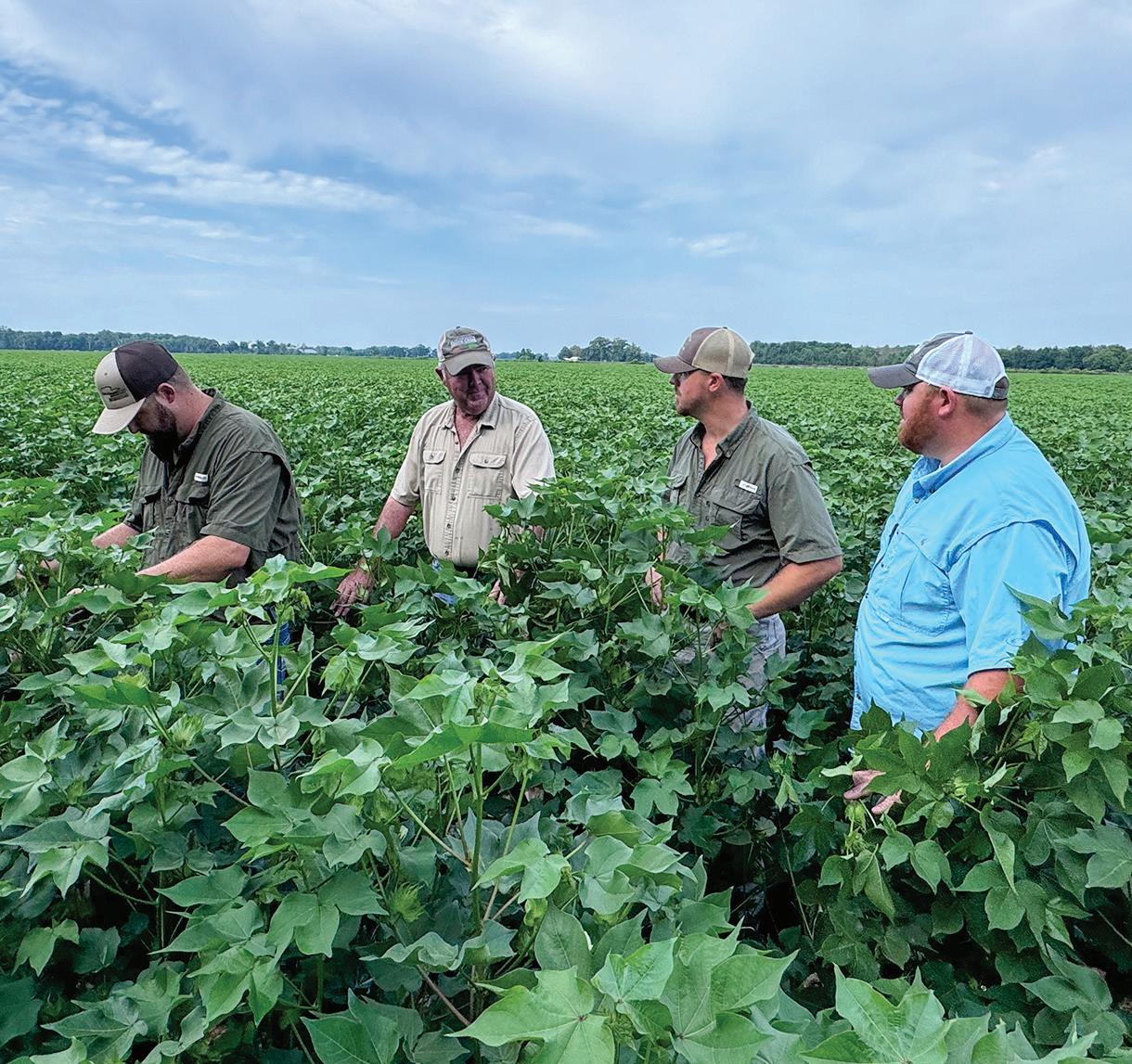
Ronald Rawls planted his first crop of cotton in 1979. Since then, his three sons, Neal, Ryan and Chad, have joined him in the Louisiana operation as fourth-generation growers. They have excelled at adopting new technologies and working hard to keep growing the farm that includes 2,500 cotton acres. “My mama’s dad on the Thornton side was a real deal cotton farmer,” Ronald said. “He owned the first mechanical cotton picker in this country.”
e U.S. Department of Interiors has li ed the boundary limitations for four national wildlife refuges — including the one in Muleshoe, Texas.
BASF and Bayer hosted eld days in the Central and Upper Gulf Coast regions of Texas. e theme that surfaced for both events was “stay ahead.”
the official publication of the ginning industry
TCGA summer interns report on their “real-world experiences.” Be aware of best practices for processing suspect re bales at cotton gins and warehouses.
To nominate a deserving candidate for the 2024 Cotton Consultant of the Year Award, co-sponsored by Cotton Farming and Syngenta, fill out the form online at cottonfarming.com/ccoy. Deadline for nominations is Aug. 15.


ON THE COVER: Ryan, Neal, Ronald and
Hank




Carroll Smith
Ahumourous, anonymous quote for what typically is considered a more serious concept is, “Family ties mean that no matter how much you might want to run from your family, you can’t.” It’s good for a chuckle, but the true definition runs much deeper.
In many farm families, ties to the land, the farming profession and each other go back three, four or even more generations. In the world of agriculture, family can be defined as blood relations, others connected by legal contract, a loyal worker who has been a fixture in the operation for many years and others with whom the principals have worked for a long time. The bonds are strong.
In North Louisiana, Ronald Rawls farms about 5,000 acres, including 2,500 acres of cotton, with his sons, Neal, Ryan and Chad, who joined the operation as fourth-generation growers. Read more details about their farming practices on page 12.
One of the long-term goals for continuing their farming tradition is getting the next generation of Rawlses involved. “The biggest priority in 20 years is that this is still a family farm,” Ronald said.
A popular farm family tradition for younger kids and their parents is the coveted invitation to “spend the day out in the fields” bouncing along the turnrows in a pickup truck. My little brother, Wes, enjoyed riding with Dad and going to the farm trailer where he screwed the tops on Mason jars full of Kool-Aid while Dad made bologna sandwiches to deliver to the field for everyone to share at lunch time.
As an aside, a friend of mine who worked on his uncle’s farm said bologna sandwiches were their lunch staple, too. A twist to the story was that his uncle liked to make up a big batch at night and put them in the freezer. In the morning, he picked out however many he needed and threw them in an ice chest with the hope — his uncle said — that they would still be a little cool by lunchtime.
Although this practice possibly makes sense, my friend said there was just something weird about eating a previously frozen bologna sandwich. But, strange as it may seem, frozen bologna sandwiches were eventually accepted as a lunchtime tradition in this particular operation.
In the end, when you weave a tapestry of family ties, traditions and rides on the turnrow, it shows the closeness of farm families is palpable. A sense of belonging, the importance of a good work ethic and knowing someone always has your back are the threads that hold it all together. Nourish that bond and never take it for granted.
If you have comments, please send them to: Cotton Farming Magazine, 7201 Eastern Ave., Germantown, TN 38138.
EDITORIAL/PRODUCTION
Editor Carroll Smith csmith@onegrower.com
Southeast Editor Amanda Huber ahuber@onegrower.com
Associate Editor Cassidy Nemec cnemec@onegrower.com
Digital Content Editor Katie Guthrie
Art Director
Ashley Kumpe
Publisher/Vice President Lia Guthrie (901) 497-3689 lguthrie@onegrower.com
Associate Publisher/Editor-In-Chief Carroll Smith (901) 326-4443
Associate Publisher/Sales Scott Emerson (386) 462-1532 semerson@onegrower.com
Production Manager David Boyd dboyd@onegrower.com
Audience Services
Kate Thomas (847) 559-7514
For subscription changes or change of address, call (847) 559-7578 or email cottonfarming@omeda.com
EDITORIAL ADVISORY BOARD
David Burns – North Carolina
David Lynch – South Carolina
Bob McLendon – Georgia
Larkin Martin – Alabama
Mike Sturdivant Jr. – Mississippi
Charles Parker – Missouri
Jimmy Hargett – Tennessee
Allen Helms – Arkansas
Jay Hardwick – Louisiana
Ronnie Hopper – Texas
Ron Rayner – Arizona
John Pucheu – California
Mike Lamensdorf President/treasurer Lia Guthrie Publisher/Vice President
ACKNOWLEDGEMENT OF COOPERATION: Cooperating with COTTON FARMING are various cotton producer organizations across the Cotton Belt. Many representatives of producer organizations serve on COTTON FARMING’s editorial advisory board. Opinions expressed and conclusions reached by contributors are not necessarily those of the cooperating organizations or the editors. All statements, including product claims, are those of the person or organization making the statement or claim. The publisher does not adopt any such statement or claims as its own and any such statement or claim does not necessarily reflect the opinion of the publisher.
Copyright 2024 ©
ASSOCIATED PUBLICATIONS – One Grower Publishing, LLC also publishes RICE FARMING, THE PEANUT GROWER, SOYBEAN SOUTH and CORN SOUTH.
One Grower Publishing, LLC 875 W. Poplar Ave., Suite 23, Box 305 Collierville, TN 38017
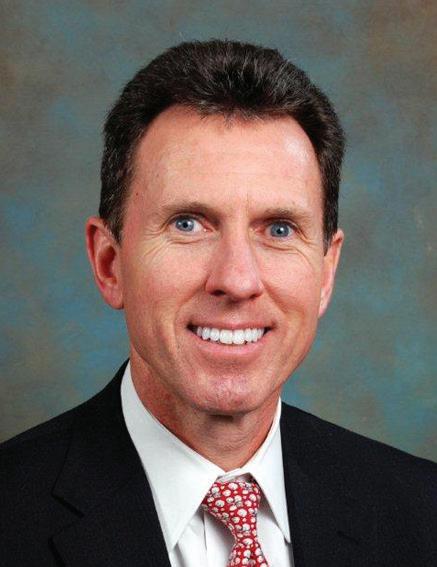
Gary Adams
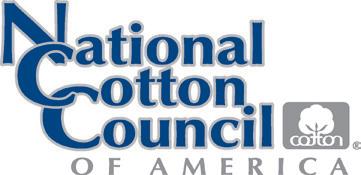
e National Cotton Council, in collaboration with e Cotton Foundation and Mississippi State University, is honored to announce the establishment of the Don Parker Memorial Cotton Foundation Endowed Scholarship.
Who is the scholarship named after?
■ Dr. Don Parker was vice president of Technical Services for the National Cotton Council (NCC). He joined the Council in 2007. He also served as manager of Integrated Pest Management where he worked closely with producers and researchers across the 17 cotton-producing states to address pest management issues facing cotton production.

He was the Council’s lead scientist in the area of pollinator protection, charged with ensuring that regulatory efforts involving pollinator protection seek coexistence of crop protection and pollinator protection based on field relevant sound science. Don served on multiple Council committees, including the Pink Bollworm Action Technical Advisory Committee, Joint Cotton Breeding Committee, Joint Cotton Industry Bale Packaging Committee and Conservation Task Force. He was the Executive Director of The Cotton Foundation and a member of The Cotton Foundation’s Research Screening Committee. He also served on the National Cotton Ginners’ Air Quality Subcommittee.
Prior to joining the Council, Don served as an entomologist at Mississippi State University, where his duties included teaching, research and extension. He published more than 67 research papers and gave numerous presentations.
What is the purpose of the Don Parker Memorial Cotton Foundation Endowed Scholarship?
■ NCC, in partnership with The Cotton Foundation and Mississippi State University, has established this scholarship initiative as a tribute to Don, who dedicated his career to advancing agricultural education, promotion and inclusivity within the agriculture industry. As a visionary lead-

NCC, in partnership with e Cotton Foundation and Mississippi State University, has established this scholarship initiative as a tribute to Dr. Don Parker.
er, he championed the cause of underrepresented minorities, recognizing their immense potential to shape the future of farming. This scholarship seeks to provide permanent financial support to deserving students who aspire to achieve degrees in agricultural-related programs.
What opportunities are available to honor Dr. Parker’s work through this scholarship?
■ Two tax deductible opportunities exist to honor Don’s work. Larger group or corporate donors may prefer to choose the permanent endowed scholarship, while individuals may wish to make an immediate impact in Fall 2025. You can support the Fall 2025 scholarship and/or the permanent endowed scholarship at Mississippi State University by visiting the MSU Foundation’s secure donation page at https://dda.msstate.edu/give-now?f=405034.
Gary Adams is president/CEO of the National Cotton Council of America.
In the fast-paced world of fashion and shopping, Cotton Incorporated plays a pivotal role in placing cotton at the forefront of consumers’ minds during their shopping journeys. By collaborating with retailers, designers and brands, Cotton Incorporated develops and funds cotton-centric shopping experiences.
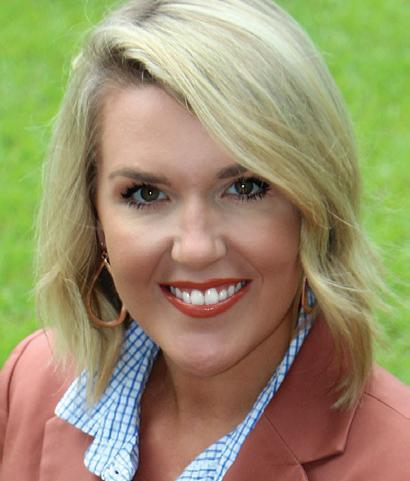
BY STACEY GORMAN WARREN, ARKANSAS
These integrated strategies encompass in-store promotions, digital and social media campaigns, celebrity endorsements and collaborations with style influencers. Brands like REVOLVE, Lucky Brand and Aeropostale have joined forces with Cotton Incorporated over the last year, successfully placing cotton in memorable and highly shoppable contexts. In fact, according to Cotton Incorporated, these collaborations resulted in over $55 million in direct cotton sales last year alone. At the core of this tactic to move more cotton lies an innate belief in the power of strategic brand partnerships. Cotton Incorporated spotlights cotton’s unparalleled versatility, comfort and fashionability by forging relationships with leading brands across the retail market. These collaborations transcend mere product placements; they are thoughtful narratives woven together to resonate deeply with consumers.
Cotton Incorporated works with those who share its values of quality, sustainability and innovation. Each collaboration is an opportunity to leverage the unique strengths of both cotton and the brand, resulting in promotions that seamlessly merge cutting-edge fashion with cotton’s natural benefits.
One great example of a brand collaboration is Cotton Incorporated’s work with iconic fashion, lifestyle and beauty brand LoveShackFancy. The 2024 partnership engages gymnast Suni Lee as the spokesperson for the Cotton x LoveShackFancy Americana Collection ahead of her participation in the 2024 Summer Games. This collection of beautiful cotton clothing embodies a re-invented sense of modernity, femininity, softness and confidence.
Cotton fabric has always played a pivotal role in creating LoveShackFancy’s signature pieces and the heritage styles the brand is known for and loved. The Cotton x LoveShackFancy “Americana” capsule collection is available through August 18 at www.loveshackfancy.com.
“Beyond the beam and the bars, there’s Suni Lee — not just the champion, but the individual. Away from the spotlight of competition, she embraces the chance to express her true self. In the comfort of cotton, Lee opts for relaxed, feminine and playful pieces, reflecting her genuine and personal style,” says Marissa Barlin, Director of Brand Partnerships for Cotton Incorporated.
“Like Suni, we all have ‘off-the-mat’ moments in our lives where we want to embrace comfort and exude confidence. The

ease, softness and beauty of cotton in this collection accomplish just that.”
Another recent example is Cotton Incorporated’s collaboration with Lucky Brand to promote cotton summer styles available to shop on LuckyBrand.com and in-store. The Cotton Shop with Lucky Brand had its own landing page and featured the Seal of Cotton logo on all 200+ women’s and men’s items within the shop.
Cotton Incorporated and Lucky Brand promoted the collaboration in a myriad of ways, including a series of email blasts, social media posts, advertising on podcasts and utilizing influencers to promote The Cotton Shop at Lucky Brand in head-totoe cotton looks on their Instagram and TikTok pages.
“Cotton Incorporated’s brand partnerships have a profound impact on cotton’s image, breathing new life into its narrative as a timeless and aspirational choice. These collaborations with renowned brands, retailers, and style influencers are a testament to the brand’s strength in the fast-evolving world of fashion and lifestyle,” said Barlin.
Through strategic brand partnerships, Cotton Incorporated is responsible for exposing millions of consumers to pro-cotton messaging each year. These collaborations not only elevate cotton as a fashionable and versatile choice but also shape the future of fashion and consumer engagement. With each collaboration, Cotton Incorporated continues to promote cotton as the fiber of choice among consumers, proving that when creativity meets collaboration, the possibilities are limitless.
For more information on curated cotton collections, go to https://thefabricofourlives.com/shop.
Stacey Gorman is The Cotton Board’s director of communications. Contact her at sgorman@cottonboard.org.
Tensas Parish, Louisiana
I worked for over 40 years with LSU AgCenter and retired in 2020 as associate vice president of the ag research and extension programs. I was then approached by a group of farmers in northeast Louisiana to work as their consultant. I’m from that area, so I moved back and consult primarily in Tensas Parish on cotton, soybean, corn, grain sorghum and wheat acres.
Most of these growers are very progressive, using technology for decision-making. My philosophy as a consultant is to consider each field individually, which fits very well with the needs of my clientele. I consult on limited acreage and spend considerable time sampling fields. I try to tailor my recommendations to the specific needs of each field or even part of a field. That’s how we manage costs, improve production efficiencies and increase yields.
Growers benefit from having options. As we look back at weed control for the past several seasons, it’s important for growers to have the flexibility to use different herbicides. When we think about using a herbicide system, we also must think about varieties, because you can’t separate the variety from the herbicide technology. So, we need good options to diversify varieties and herbicide systems, because that will help keep yields up and help us manage weed resistance.
We have found some PhytoGen® W3FE varieties that perform well in our area. PhytoGen varieties perform well in high-yielding cotton environments. One benefit is the nematode resistance. We have a bigger nematode problem than many growers realize in our highly productive, lighter-textured soils. Nematodes are limiting yields, and consultants are thinking more about nematodes when making variety recommendations. That is just another piece of the puzzle that plays into variety selection.
The Enlist® weed control system also is very effective against weeds and weed resistance. We could see an increase in more acres of the Enlist system because of the current situation with dicamba. One important consideration for the Enlist system is flexibility. You can use Enlist One® herbicide as well as glufosinate and glyphosate — and the option to tankmix Enlist One with those other products, if needed. We can pick and choose the herbicide applications that best fit our fields. That gives growers more flexibility, and flexibility is so important right now.
Compared to older forms of 2,4-D, Enlist herbicides give us the ability to keep our applications much more on target when following the proper application guidelines. That is an important point for growers to know.
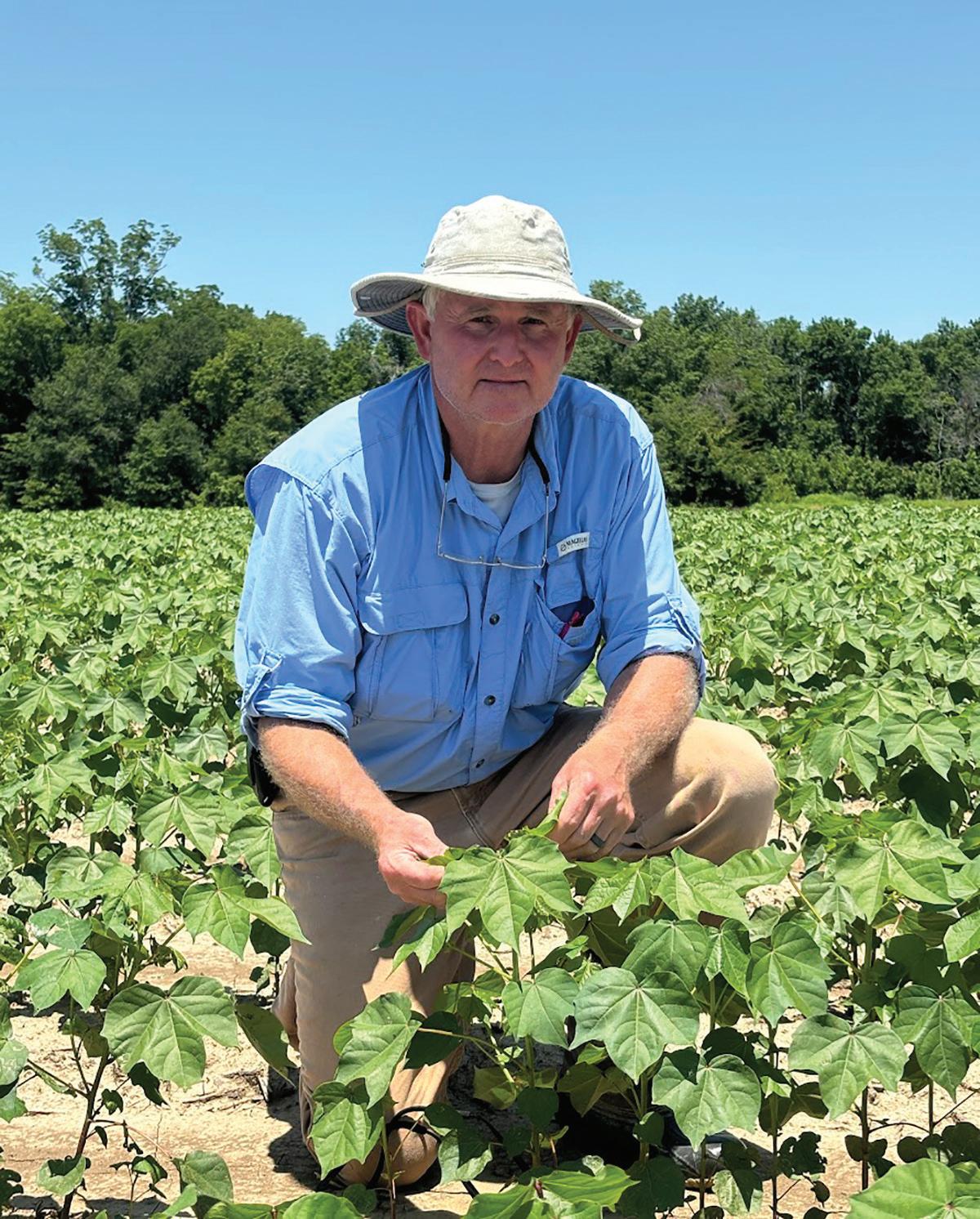
• Ph.D. in Entomology, Louisiana State University.
• Retired from LSU AgCenter in 2020 as associate vice president of the ag research and extension programs.
• Consults on cotton, soybeans, corn, grain sorghum and wheat.
• Primarily covers Tensas Parish in Louisiana.
• Wife Thoy. Son Daniel, daughter Katelyn, and five grandchildren.
1. We need good options to diversify varieties and herbicide systems, because that will help keep yields up and help us manage weed resistance.
2. PhytoGen® W3FE varieties perform well in high-yielding cotton environments. One benefit is the nematode resistance. We have a bigger nematode problem than many growers realize in our highly productive, lightertextured soils.
3. One important consideration for the Enlist® weed control system is flexibility. You can use Enlist One® herbicide as well as glufosinate and glyphosate — and the option to tankmix Enlist One with those other products, if needed.
BY MEGAN WINSLOW UNIVERSITY OF FLORIDA
The United States leads the world in cotton exports by value, accounting for $5.7 billion, or 33%, of exports of the textile, according to the U.S. Department of Agriculture. But researchers hope to bolster American production even more through a pair of studies designed to identify the most robust cotton seed varieties available.
Thirteen universities, including the University of Florida, are participating. Each university is in a cotton-producing state. In addition to the University of Florida, they are North Carolina State, the University of Missouri, Texas A&M, Oklahoma State, Arizona State, Kansas State, Mississippi State, Virginia Tech, Clemson, Auburn, the University of Georgia and the University of Tennessee.
Sudeep Sidhu, a UF Institute of Food and Agricultural Sciences (IFAS) agronomist is spearheading the Florida studies from the UF/IFAS North Florida Research and Education Center in Quincy.
“Trials like this serve as a benefit to farmers and to seed manufacturers because they get to know their production potential,” Sidhu said.
Both studies are sponsored by Cotton Incorporated, a not-for-profit company that supports industry research.
The aim of the first study is to understand cotton seed germination potential in less-than-ideal growing conditions, specifically, when soil temperatures are cool.
The optimal soil temperature for cotton seed germination is between 65 and 85 degrees Fahrenheit. In Florida, this means seeds are planted from late April to early June, depending on whether irrigation is available. Harvest generally takes place around October.
Sidhu and his counterparts at the participating universities each received 23 cotton seed varieties from seed manufacturers, and they planned to sow them
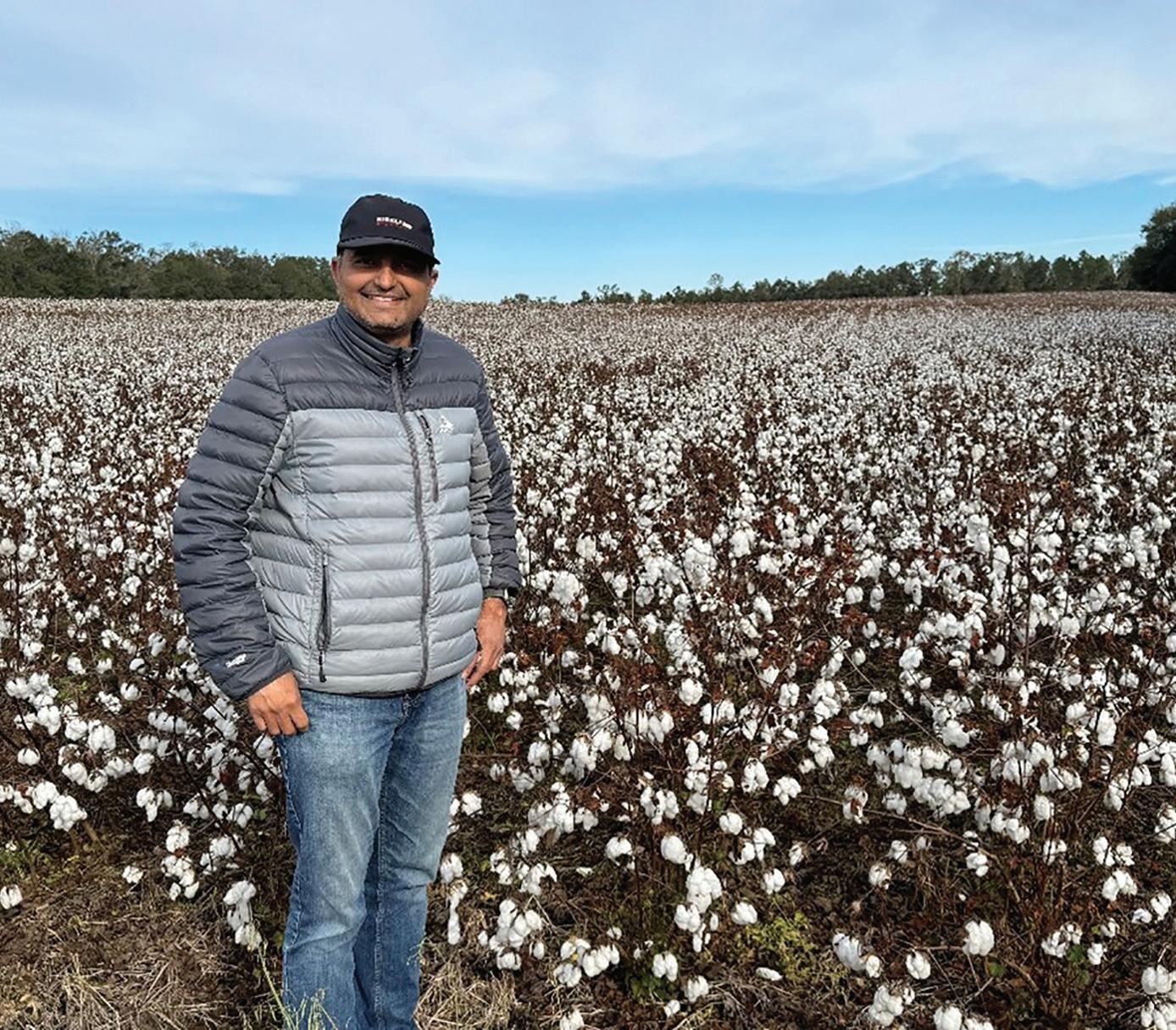
before daytime soil temperatures rise above 70 degrees.
The seeds are marked, but their variety is unknown to the researchers. Once the seedlings emerge from the soil, the researchers will measure the length of their radicle or primary root.
Current cool-temperature seed-germination protocols dictate germination only takes place when a plant’s radicle length reaches 4 centimeters, or approximately 1.6 inches.
“The rationale behind this study is to develop more information on the cool germination behavior of these 23 different varieties so we have more data to see if we still need that 4-centimeter length as a threshold to consider germination,” Sidhu said.
The second study, a cotton variety
evaluation partially underway, is geared toward determining which cotton seed varieties grow best in particular climates. In Florida, 26 seed varieties will be sown in four counties: Gadsden, Jackson, Jefferson and Suwannee.
The seeds, donated by industry partners, will be grown under irrigated and non-irrigated conditions as small plot replicated trials in Quincy and Live Oak. Between 10 and 12 of these varieties will be planted without irrigation on farms in Jackson and Jefferson counties.
The success of the on-farm trials would not be possible without the help of collaborating growers, Sidhu said.
“The purpose of this project is so all cotton specialists in the United States should be able to tell their stakeholders which varieties perform better for their location or for locations around their farm,” he said.
BY MARY HIGHTOWER UNIVERSITY OF ARKANSAS SYSTEM DIVISION OF AGRICULTURE
The June acreage report from the U.S. Department of Agriculture showed cotton with its highest acreage in more than a decade and soybeans on the rise, while corn tumbled and rice shuffled between long- and medium-grain acres in Arkansas.
“June acreage is more or less a reality check for the March Planting Intentions report,” said Scott Stiles, Extension agricultural economics program associate for the University of Arkansas System Division of Agriculture.
With the principle crops planted, acreage is down 0.8% to 7.156 million acres in Arkansas; total planted in the United States is 315 billion acres, down 1.4% from the previous year, NASS said.
Corn
Corn acres dropped 27.1% to 620,000 acres, unchanged from the March planting intentions.
“Corn prices have been on a downward slide for much of the past year,” Stiles said. “Futures prices for new crop corn were about 20% below the previous year when NASS surveyed growers in early March.”
Jason Kelley, Extension wheat and feed grains agronomist for the Division of Agriculture, said he wasn’t surprised by the acreage report.
“Lower grain prices, combined with less-than-ideal planting conditions for some, led to the drop in Arkansas acres,” he said. “The spring was too wet, especially in the southern half of the state. Northeast Arkansas, overall, had better planting conditions than the rest of the state, with dry weather in late March and early April.”
Cotton
Cotton acres were up 31.4% to 670,000 acres in Arkansas, while total U.S. acres were also up 14.1%.
“The huge surprise in today’s report was NASS’ cotton acreage number,” Stiles said. “In March, growers indicated they would increase acres by a modest 30,000 acres to 540,000. However, in June, acres are expected to be 670,000; up 160,000 from last year. This would be the highest cotton acreage for the state since 2011, which saw 680,000 acres.”
He said that while there were solid indications we have 610,000 to 620,000 acres in the state, “the 670,000 acres was surprisingly high.
“Cotton prices started a nosedive in early April, losing about 13 cents by mid-June. Prices fell from the low 80-cent level to 70 cents,” Stiles said. “But, cotton yields in the state continued to climb, and growers exited 2023 with record yields. Also, the crop insurance price of 82 cents this year may have played a role in adding acres. There was some shifting from corn to cotton going on as well.”
“In terms of cotton, we’re in good shape,” said Zachary Treadway, Extension cotton and peanut agronomist for the Division of Agriculture. “Some guys are in the first week of
Soybeans2,980,0003,050,000 +70,000 +2%
Cotton510,000670,000 +160,000+31%
Peanuts35,00035,000 0 0
Source: USDA-NASS, June 2024
bloom and some are into the second week of bloom, but what’s really important is water. It’s getting hot and dry, and we want to keep putting moisture on the crop so we’re not stressing it.”
“Peanuts remained the same, which is what I was expecting based on what growers were saying,” Treadway said.
NASS pinned peanuts at 35,000 acres, same as in 2023.
Overall, total rice acres were down 15,000 acres from last year in NASS’ findings to 1.42 million acres, compared to just under 1.44 million acres in 2023. Stiles said he was a little surprised by the 40,000-acre decline in long-grain rice acres from March.
“The June survey results are a little puzzling considering the planting progress this year and the rice market rally that kicked off in early April,” he said. “Generally, in years when planting progresses at a faster-than-average pace, we tend to see a higher acreage number in June. USDA did increase medium grain acres by 10,000 above their March number.”
Jarrod Hardke, rice Extension agronomist for the Division of Agriculture, said he too was a little surprised by the dip, but it was within his range of expectations between 1.4 million and 1.5 million acres. A shortage of long-grain seed played into the shuffling of acres over to medium grain, he said.
NASS reduced Arkansas soybean acres by 50,000 from the March intentions to 3.05 million. However, that was still up 2.3% from 2023. The U.S. total was up 3% to 86.1 billion acres.
“This is still an increase of 2% or 70,000 acres over last year,” Stiles said. “Considering the sharp drop in corn acres, some resulting increase in soybeans is not a surprise. Similar to corn, soybean prices have trended lower over the past year. There is a very bearish feel to the soybean and corn markets this year.”
Jeremy Ross, Extension soybean agronomist, said, “The estimates were in line with what I was expecting. With the drop in soybean prices compared to last year, I’m getting a few more calls with farmers and consultants asking about different inputs for preserving or increasing soybean yields.”
Twelve U.S. cotton industry members are participating in the National Cotton Council’s Emerging Leaders Program for 2024-25.
Participants include: PRODUCERS – Clint Dunn, Itta Bena, Mississippi; Lambert Marshall, Scott, Arkansas; Greg Riccomini, Bakersfield, California; Todd Rovey, Buckeye, Arizona; Greg Sikes, Brooklet, Georgia; and Jack Whatley, Odem, Texas. GINNERS – Nathan Goldman, Casa Grande, Arizona; Daniel Luehrs, Odem, Texas. MERCHANTS –Brett Edgy, Savannah, Georgia; Jacinta Condon, Greenville, South Carolina. WAREHOUSER – Chris Moore, Southaven, Mississippi and MARKETING COOPERATIVE – Zach Flowers, Clarksdale, Mississippi.
Now in its ninth year, the NCC’s Emerging Leaders Program is supported by a grant to The Cotton Foundation from Bayer.
NCC Chairman Joe Nicosia, a Cordova, Tennessee, merchant, said, “We are grateful for Bayer’s ongoing support of the Emerging Leaders Program. U.S. cotton needs dedicated leaders who are committed to helping our industry maintain a competitive edge in the global marketplace.
“This initiative is helping to identify men and women who have demonstrated the potential for taking on this important challenge and then encouraging and equipping them for this important task.”
The U.S. Department of Agriculture Risk Management Agency published final 2023 county yields for Upland cotton on July 3 and approved insurance providers (AIPs)have begun sending out final indemnity payments to Upland cotton producers who purchased 2023 crop year Stacked Income Protection Plan (STAX) policy endorsements.
For most of Texas, drought and belowaverage yields were the common theme in 2023, and producers who purchased STAX — as a supplement to their regular multi-peril crop insurance — will see indemnity payments triggered in almost every Texas county where those policies are available.
Looking specifically at STAX in PCG’s
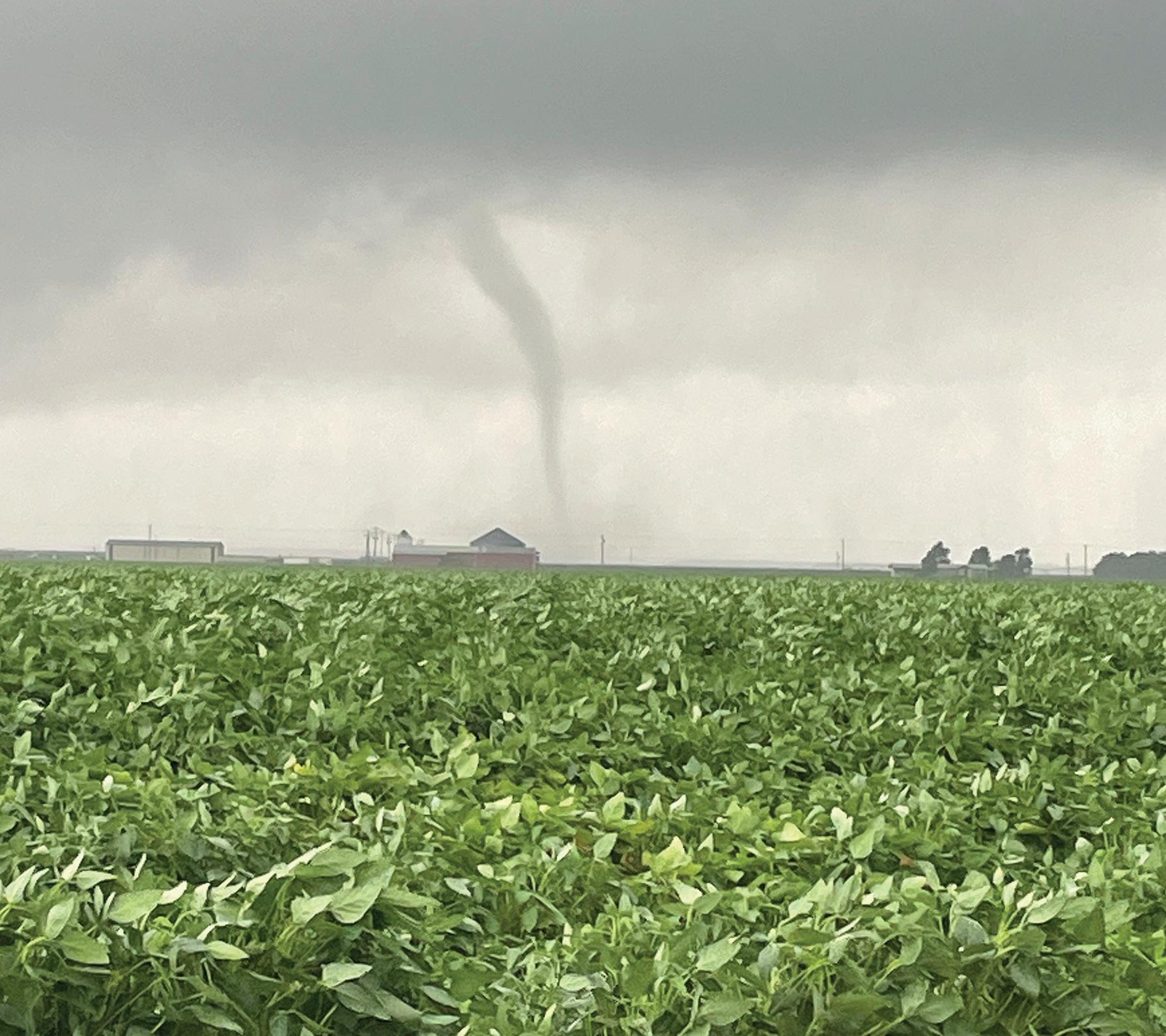
service area, every county in the region triggered indemnities on both irrigated and non-irrigated cotton. It is no surprise that each of the 41 STAX-eligible counties triggered the maximum possible payment rate under the 2023-crop policy for non-irrigated.
Irrigated was a slightly different story as STAX losses varied across the PCG area. While a majority (32 out of 41) of PCG’s counties triggered the maximum possible STAX payment on irrigated acres, the final irrigated yield per planted acre reported by RMA in nine counties (Armstrong, Crosby, Floyd, Garza, Hale, Hockley, Lubbock, Lynn and Motley) resulted in less than maximum payment rates for irrigated cotton.
STAX payment rates in the rest of Texas followed a similar pattern with indemnities triggered on at least one practice in all but three counties statewide. Those three counties (Culberson, El Paso and Hudspeth) are all located in the Trans-Pecos region where STAX is available only for irrigated cotton.
Seven other Texas counties triggered STAX payments on only one practice. Five of those counties (Hidalgo, Jim Hogg, Starr, Willacy and Zapata) are in the Lower Rio Grande Valley and triggered STAX payments on irrigated acres only.
The other two counties (Victoria County in South Texas and Caldwell County in the Blacklands region) triggered STAX payments only on non-irrigated acres.
Beryl, which existed as everything from an Atlantic hurricane to a tropical depression, brought high winds and rainfall to large swaths of Arkansas this week, but left the vast majority of the state’s row crops intact.
Hurricane Beryl caused significant damage in the Caribbean as a Category 5 hurricane during the first several days of July. It continued west and north, making landfall in Texas as a Category 1 hurricane. As the storm system moved inland, it was downgraded to a tropical depression.
The National Weather Service in Little Rock reported record rainfall amounts, including:
■ Batesville: 4.51 inches beating the previous record of 2.42 inches set in 2021.
■ Harrison: 2.33 inches beating the previous record of 1.72 inches set in 1905.
■ North Little Rock: 2.87 inches beating the previous record of 0.90 inches set in 2014.
■ Little Rock: 2.56 inches beating the previous record of 1.74 inches set in 1956.
Other areas of the state saw even higher amounts of rainfall, including 8 inches in Grant County, 5.36 inches in Heber Springs, 6.6 inches in Conway County and 7.31 inches in Ferndale.
The weather system also spawned numerous tornadoes in areas of Arkansas and northern Louisiana, along with large numbers of attendant warnings (NWS Shreveport issued 67 tornado warnings, averaging about 8 per hour).
While many areas of the state suffered damage to structures, reports of row crop damage throughout the state appear minor.
Matthew Davis, Jackson County Extension staff chair, said that while the White River rose significantly in his area as compared to previous levels, damage appeared to be limited to “blown levees and slow drainage on some fields.”
The Senate Appropriations Committee voted unanimously to approve a bill to



provide $27.05 billion in FY25 topline funding for the activities of the U.S. Department of Agriculture and the Food and Drug Administration.
The House Appropriations Committee voted 29-26 to advance its own version of an FY25 USDA-FDA funding bill, which provides $25.87 billion in topline spending.
Final appropriations legislation, which may reach the floors of the House and Senate in the coming weeks, is expected to provide $15.5 million in FY25 for cotton pest eradication efforts and to direct the National Agriculture Statistical Services to reinstate the Cotton Objective Yield Survey and all County Estimates for Crops and Livestock.
Matt Lee, vice president for agriculture and dean of the College of Agriculture, delivered a live organizational update from the LSU AgCenter Burden Museum and Gardens, showcasing significant achievements and outlining plans for the AgCenter and the College of Agriculture.
Lee reported a significant increase in
grant funding secured by faculty, with total new grant awards for the fiscal year reaching $40 million, a 29% increase from previous years. Additionally, research expenditures, a key metric of research activity, rose by 15% for the second consecutive year, indicating a substantial growth in research efforts and financial support.
Fundraising commitments through the LSU Foundation, 4-H Foundation and FFA Foundation surpassed $6.4 million in new philanthropic contributions, marking a 42% increase from the previous year. Lee attributes this growth to the strong support of donors and industry partners across the state who recognize the value of the programs and resources offered by the LSU AgCenter.
This year’s legislative session was successful, securing $6 million in one-time funds for campus equipment and instrumentation, along with approximately $85 million in ongoing authorizations for capital improvements. A key focus this year has been relationship-building with new representatives and senators, which has been instrumental in achieving these legislative successes.
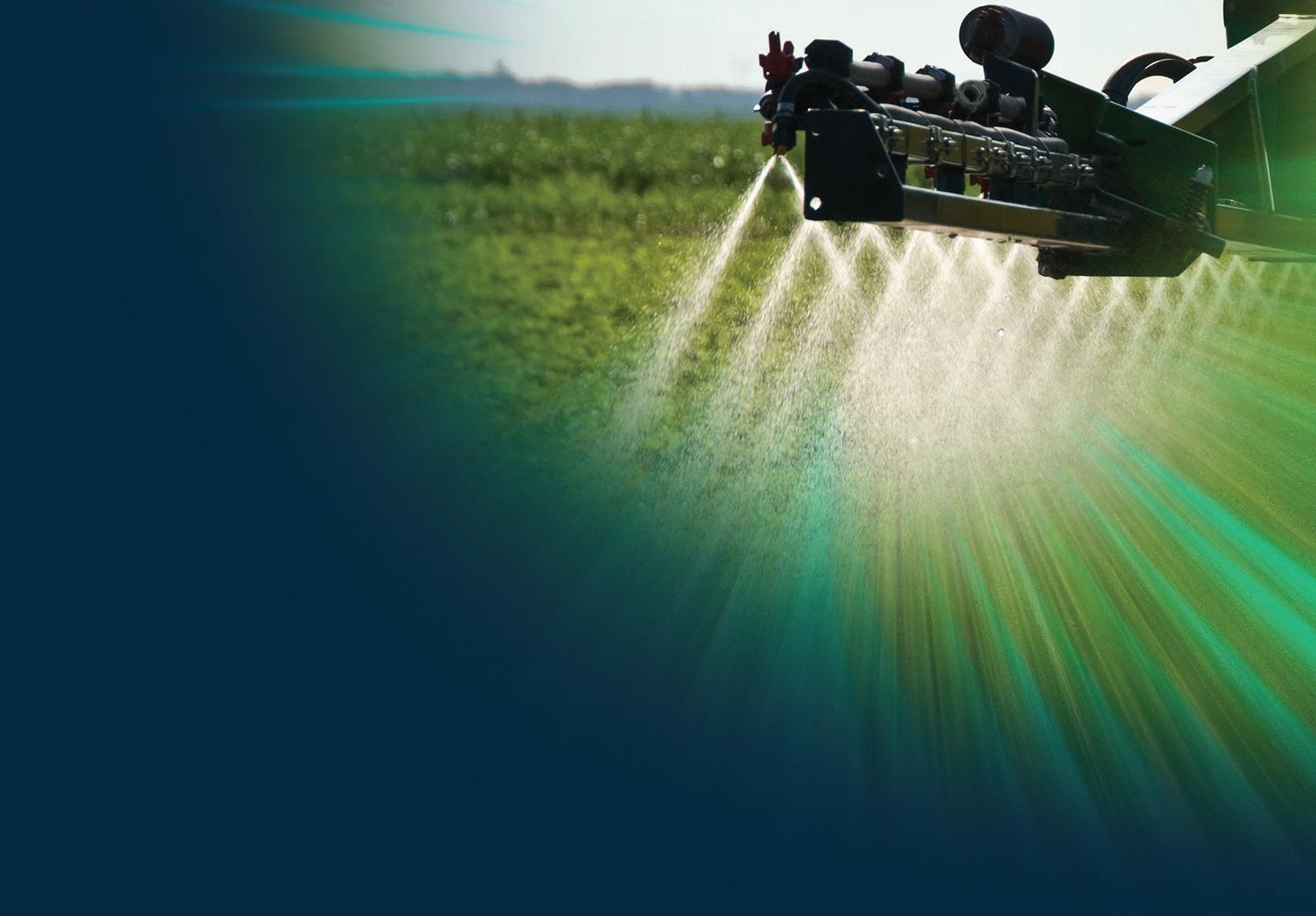















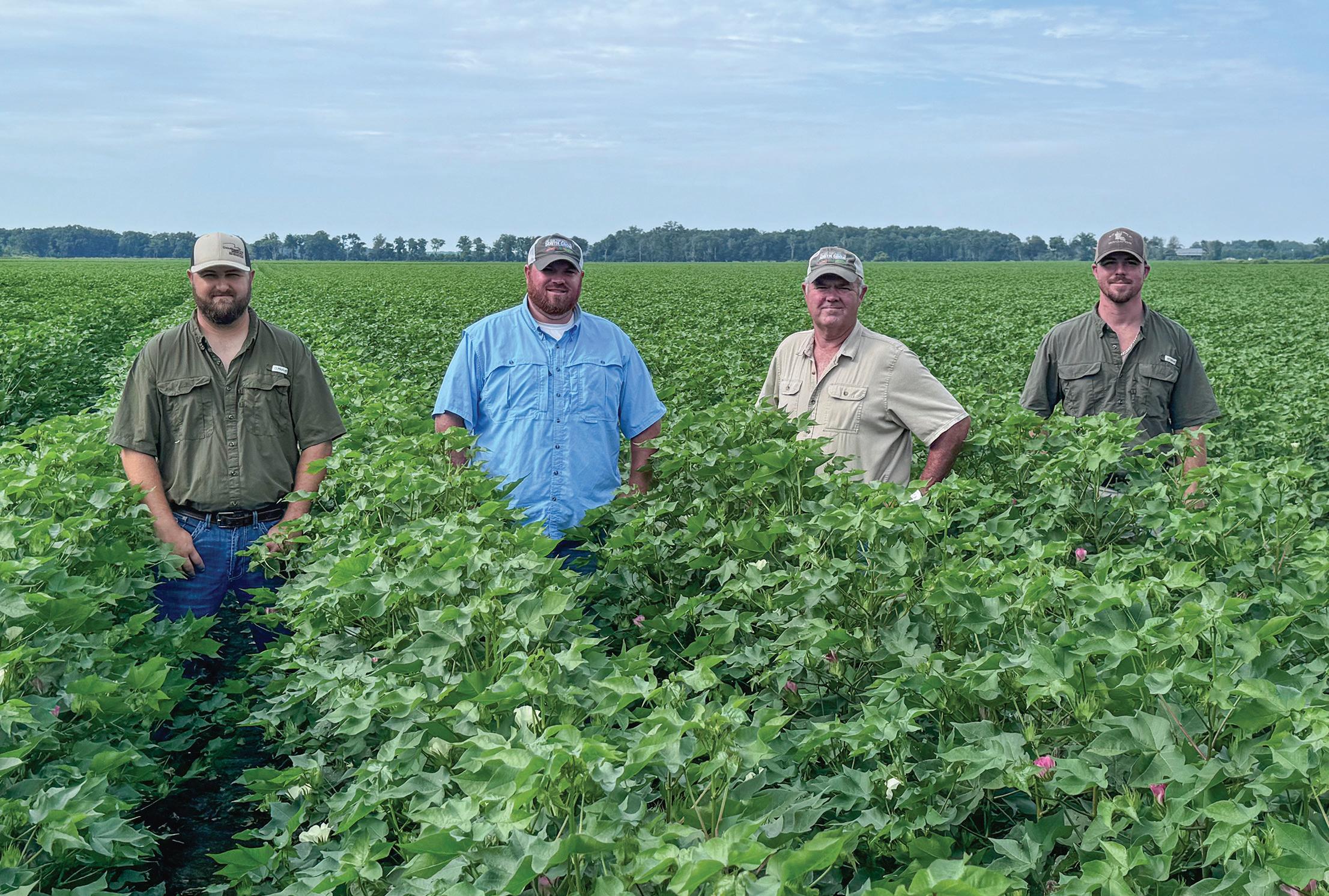
BY CASSIDY NEMEC ASSOCIATE EDITOR
Ronald Rawls planted his first crop of cotton in 1979. Since then, his three sons Neal, Ryan and Chad have joined him in the operation as fourth-generation growers, and they have excelled at adopting new technologies and at working hard to keep growing the farm.
The Rawlses farm about 5,000 acres across a 30-mile stretch between West Carroll and Richland Parishes around Rayville, Louisiana. 2,500 acres of their crop mix is cotton, with the remainder split between soybeans and corn, of which 95% is irrigated.
“My mama’s dad on the Thornton side was a real deal cotton farmer. He owned the first mechanical cotton picker in this country,” Ronald said. “He’d take it down to South Texas and pick cotton. He did that for years.”
In 1964 — the year Ronald was born — his dad started farming cotton in North Louisiana before Ronald’s first crop in 1979.
“It can be a blessing or a curse getting to see all the hard work you put in at the end or watch Mother Nature take it.”
CHAD RAWLS
The Rawlses and two other workers split up their responsibilities throughout the season. Ryan Rawls, Ronald’s middle son, does all the spraying, while Neal and Chad focus more on harvest.
Insect, weed and disease issues range on the farm. They have Roundup-resistant grass as their main issue weed-wise and pigweed, which they currently tackle with dicamba.
They have all their cotton acres in Deltapine ThryvOn varieties, and they no longer have to spray for thrips. As far as plant bugs go, they are seeing an immense decrease in pressure.
“There was one year we had to spray seven or eight times [for plant bugs],” Ryan said. “We were spraying every week, then last year we only had to spray three times.”
They also have some nematode pressure but work with that through crop rotation with corn and soybeans. “We try to keep it all in rotation so they don’t build up,” Ronald said.
Over the past few decades, the Rawlses have noticed a multitude of changes in farming. Some of these include the steep hike in input, equipment and fuel prices, but a lot also include the increase in speed and overall efficiency in agriculture. They, in turn, have adopted many new technologies to aide in efficiency on their operation.
“We use all the latest John Deere equipment technology like JD Link now,” Ryan said.
One of their favorite recent additions is an ExactEmerge high-speed planter purchased in 2022. “That really has made a major difference,” Ronald said.
“We still have one regular planter, too,” Chad said. “We plant faster and we harvest faster.”
Ronald said harvest is much different compared to when he first started out farming as far as the timing goes. “Back then, you didn’t put a lot of money into your crop until the tail end, so if your crop didn’t look good, you could cut it off. Now, when you buy that bag of seed, you’ve paid for all of that upfront, but these new varieties are so much better than what we used to have.”

Chad noted the increase in irrigation efficiency as well after they went from 12 pivots to four. “We got rid of a lot of pivots and have a lot of leveled ground now.”
Struggles on the farm include the ever-changing weather, labor shortages and again, weather. “I’ve been farming since 2004, and this is the worst spring I’ve ever experienced weather-wise,” Neal said. “That’s the big advantage of our planter because you may only have a two-day window between weather activities, but you could plant a lot in that short period of time.”
This year specifically, with the weather pattern that was in North Louisiana, the Rawlses cotton had a wide planting window. Chad noted they had cotton planted from April 24 to June 9.
On the flip side, having the flexibility to work their own hours is rewarding to each of them. “A good crop and a good price with it always helps, too,” Chad said.
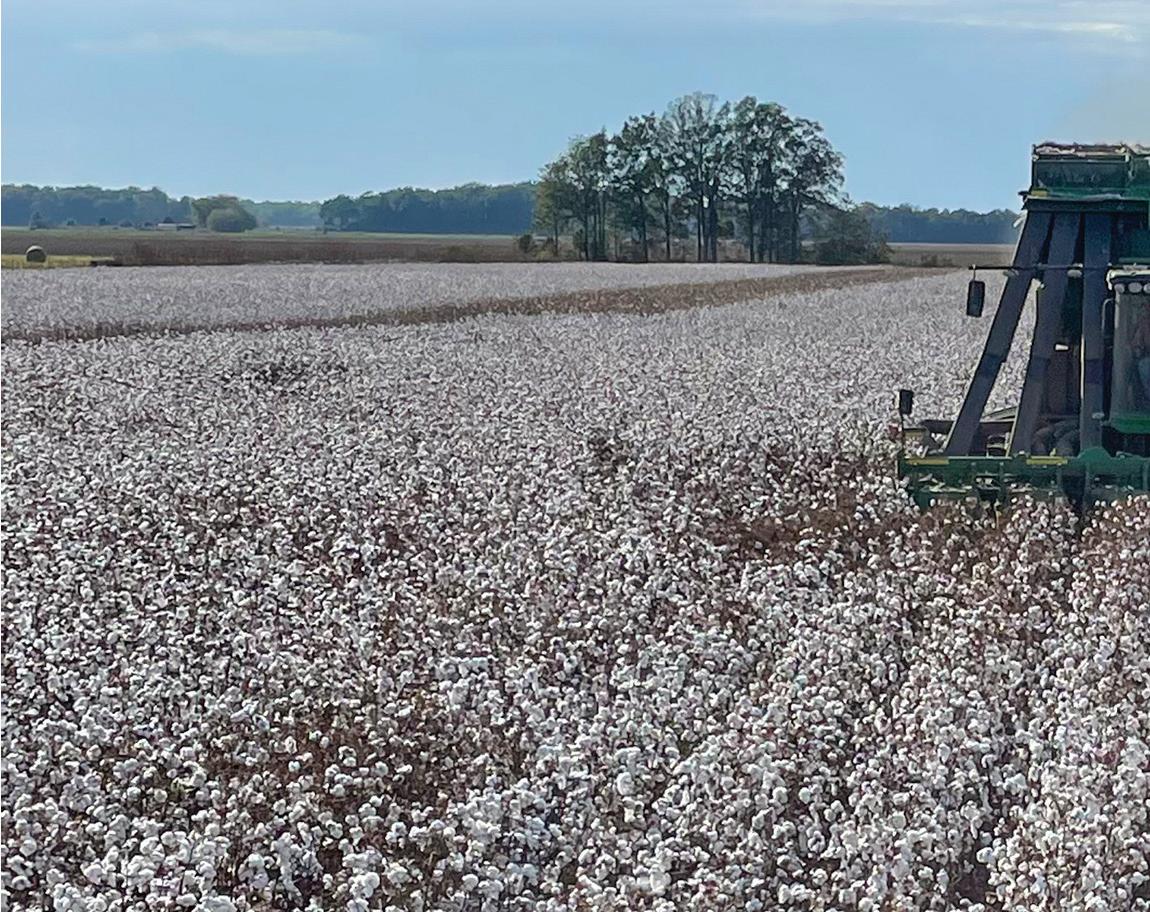
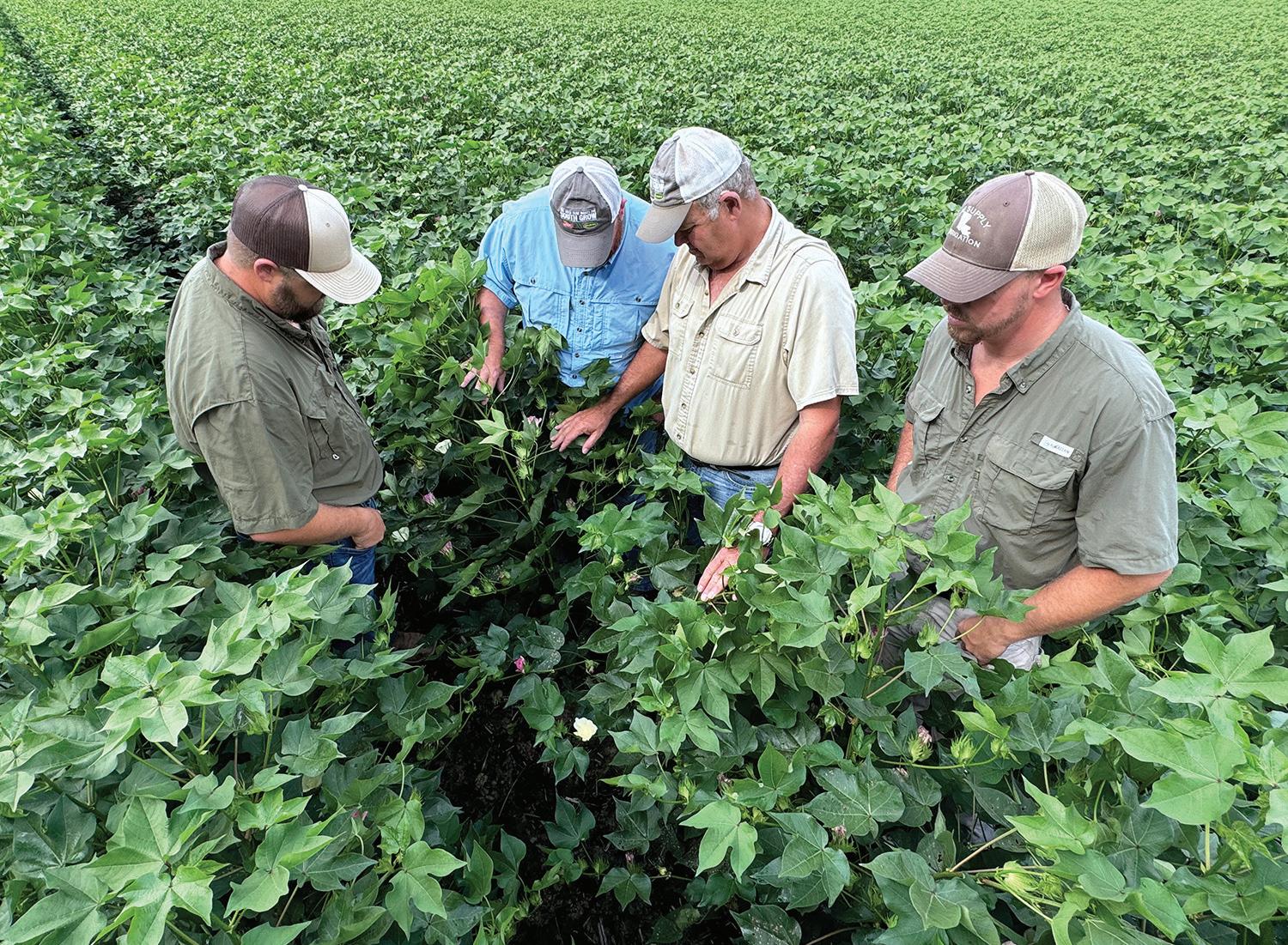
“ e biggest priority in 20 years is that this is still a family farm,” Ronald Rawls said.
Farming in North Louisiana has its challenges and rewards like anywhere else, but the Rawlses have made the best of what they can control in order to improve their operation.
Short-term plans for the farm include making and paying off long-term investments.
“I’d like to see the rest of our ground get leveled and our equipment paid off,” Neal said.

“Aside from that, there isn’t much we can control,” Chad said. “You can’t control the weather, inputs or price.”
Some of their more long-term goals comprise of getting the next generation of Rawlses involved on the farm.
“We have one grandson who — there’s no doubt about it — he’s interested in it,” Ronald said.
“I hope my kid is out here driving that spray rig for me,” Ryan said.
“The biggest priority in 20 years is that this is still a family farm,” Ronald said.
At the end of the day, the Rawlses enjoy getting to produce a crop year after year.
“I like planting as much as I do harvesting,” Neal said.
“It can be a blessing or a curse getting to see all the hard work you put in at the end or watch Mother Nature take it,” Chad said.
“I like the harvest,” Ronald said. “When we defoliate the cotton and it’s all white — I just love that time of year.”
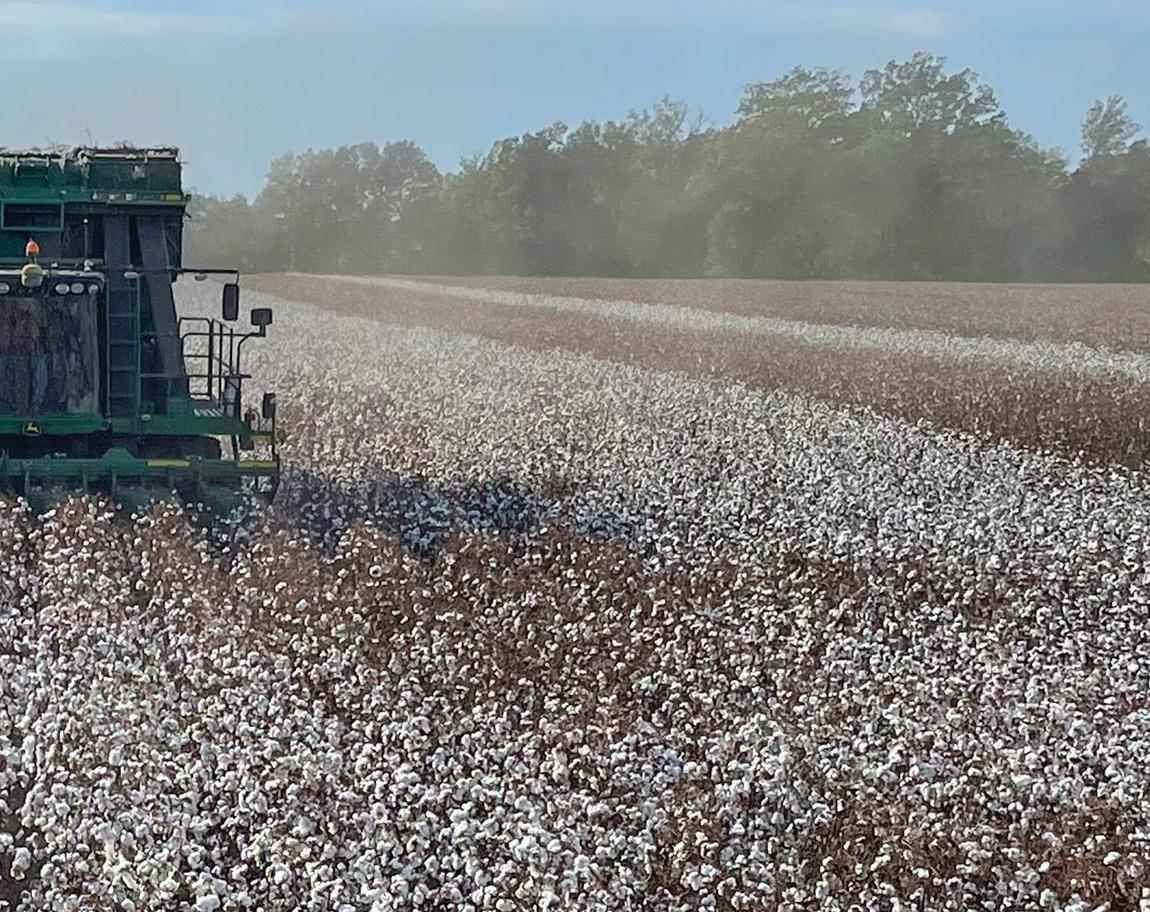

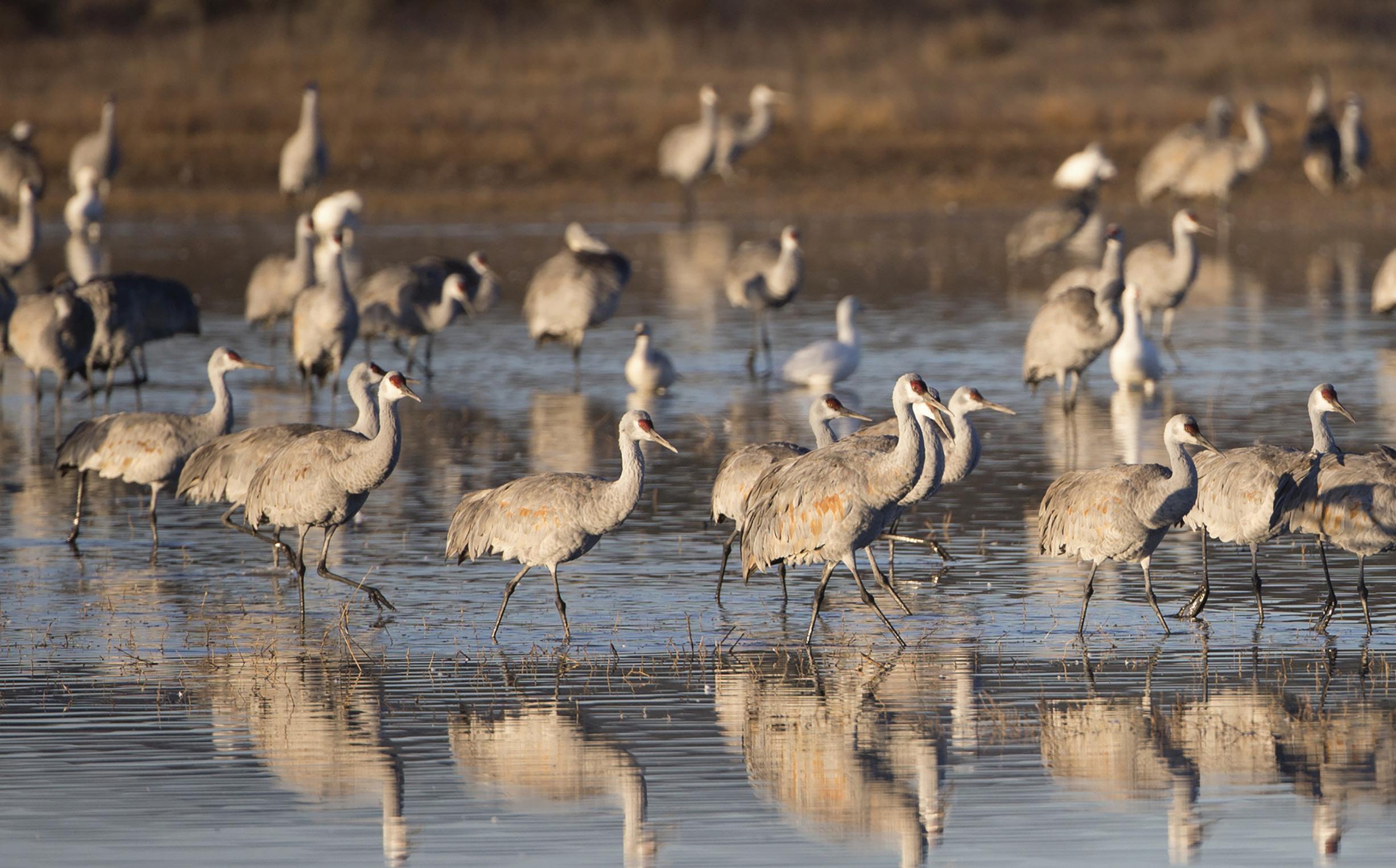

In early April, four national wildlife refuges — including Muleshoe — received support from the federal government to expand their acreage. The original boundary set by the government limited potential growth, so the U.S. Department of Interiors lifted the boundary limitations. However, there is no eminent domain process involved. It is all freedom of choice as to whether someone wants to sell their land to the refuge.
“Some of my best friends are cotton farmers,” said Jude Smith, manager of the Muleshoe National Wildlife Refuge and overseer of the expansion project. “We’re just looking to expand our conservation endeavors for wildlife and wetlands, but we’re not taking it by force.”
He went on to say some of the information being distributed by the American Stewards of Liberty group is a little misleading. The nonprofit champions private property rights and have dedicated a page of their website to what they call the “Muleshoe Land Grab.”
While the new plan allows the refuge to expand up to 700,000 acres in the Southern High Plains of West Texas and Eastern New Mexico, it doesn’t mean that the land will automatically be given to them or taken by force from the landowner. The plan will take decades to reach the goal set, according to Smith, and “will hope-
fully provide a flexible plan into the future for everyone involved.”
“Yes, it’s voluntary,” said Margaret Byfield, executive director of the American Standards of Liberty. “However, we are concerned that land will be taken under federal control through conservation easements or regulatory pressure from the government.
“They create the problem for landowners by regulating practices through the Endangered Species Act, and then they come in with the solution: we’ll buy your land and then you won’t have to worry about it.”
Byfield goes on to say that conservation easements can potentially yield all control to the government as well. If entering a conservation easement contract, it’s important to read the fine print, and, according to Jay Bragg, associate director of Commodity and Regulatory Activities for Texas Farm Bureau, consult with your attorney, family and heirs. “This is a big decision,” agreed Smith. “No one should ever feel rushed to enter into an agreement.”
However, if landowners pay careful attention to their contracts should they desire to enter into one, they still retain ownership of the property even if they sell their development right through a conservation easement.
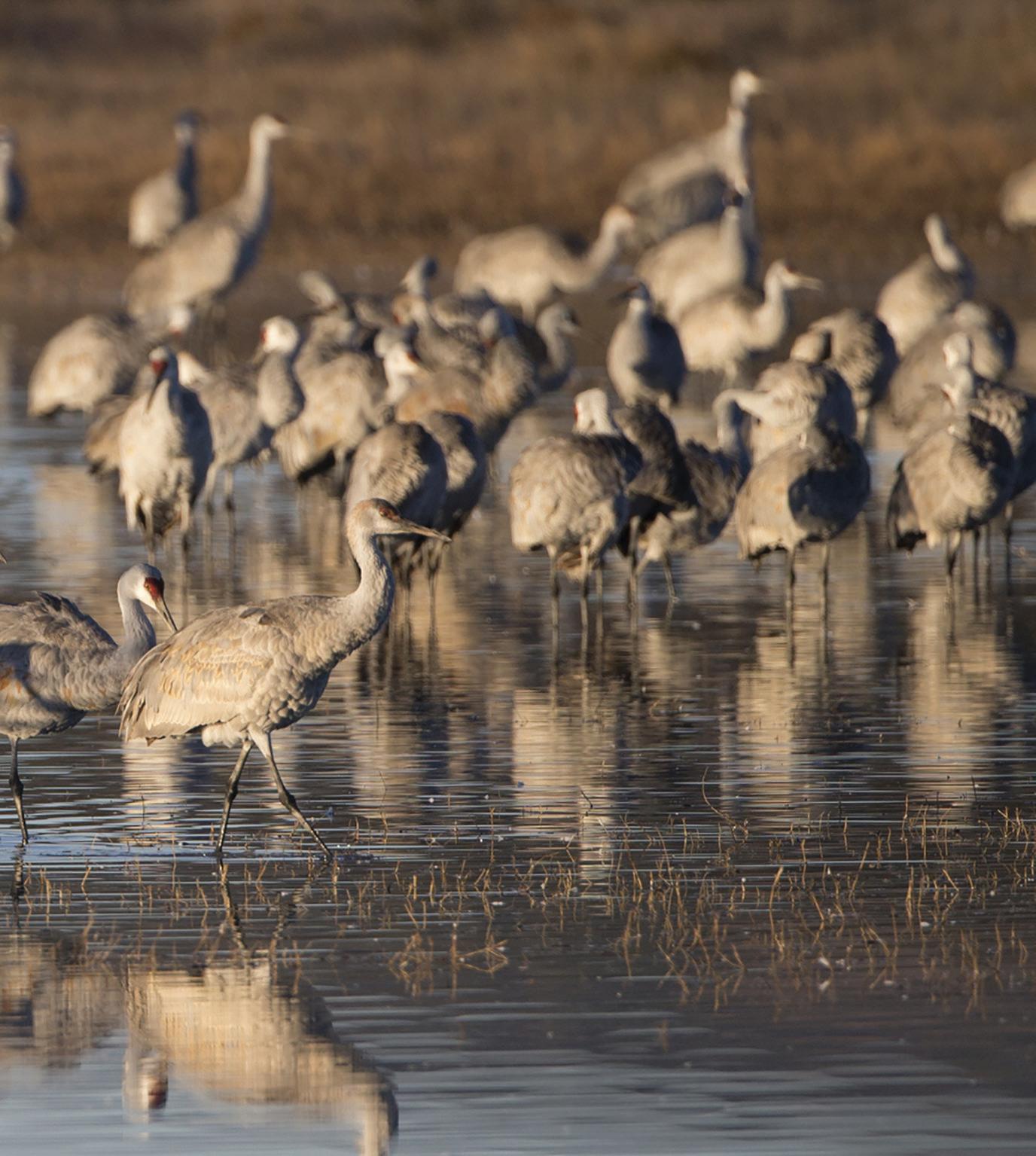
Byfield claims this plan was enacted to achieve the goals of the Biden Administration’s “America the Beautiful” initiative — also known as the 30×30 vision within Biden’s climate crisis executive order issued shortly after he took office in 2020. The 30×30 vision aims for the United States to conserve at least 30% of U.S. lands and freshwater and 30% of U.S. ocean areas by 2030.
“It’s all about government control, which will decimate local economies by taking land out of production and out of local county tax revenue,” Byfield added.
Smith emphasized the choice behind this plan. “It’s just an option for landowners who have been asking for this for more than a decade. They don’t have to sell, and we won’t take the land from them.”
PCG Weighs In
Following are Plains Cotton Growers’ key takeaways from visiting with both the American Stewards of Liberty and the Muleshoe National Wildlife Refuge:
■ Read all the fine print from both sides.
■ Talk to both parties before coming to an opinion.
■ Calling this plan a land grab is inaccurate.
■ There isn’t a “removal of acreage” — it’s an optional transaction should someone wish to sell or contract a conservation easement.
■ If you “cross your t’s and dot your i’s” on the conservation easement contractual agreement, then you retain ownership rights of property.
■ When evaluating land sales to the refuge or conservation easement, consult an attorney.
■ Eminent domain is not involved in this process.
■ This is not a federal mandate.
This article is courtesy of Plains Cotton Growers Inc. The information provided is not intended to constitute legal advice.
According to the U.S. Fish and Wildlife Service, it has released a final land protection plan that allows for the protection of up to 700,000 acres of wildlife habitat in the Southern High Plains region along the Texas-New Mexico border as part of the Muleshoe National Wildlife Refuge. The plan aims to deliver in-perpetuity conservation of up to 700,000 acres of land for benefit of migratory and resident wildlife.
Within this new limited acquisition boundary, the service would work with willing sellers to expand conservation through fee title and easement acquisitions.
Investment in, and expansion of, the National Wildlife Refuge System furthers the Biden-Harris administration’s work to support community-driven efforts to conserve and restore the nation’s lands and waters through the America the Beautiful initiative. Under Secretary Haaland’s leadership, the department has also established four new refuges.
The service worked with partners to identify a conservation strategy and the limited acquisition boundary that will support sandhill crane, pronghorn and lesser prairie-chicken, as well as a full suite of other wildlife that relies on the grassland and wetland habitat types.
The plan encompasses a portion of the Southern High Plains region in New Mexico and Texas where habitat for sandhill crane, pronghorn and lesser prairie-chicken remains. This habitat can be readily enhanced through connectivity corridors and preservation of existing large block grasslands, playa wetlands and saline lakes.
“This plan is a critical step in protecting the future of the Southern High Plains for iconic species like the sandhill crane and lesser prairie-chicken,” said Amy Lueders, the Service’s Southwest Regional Director. “These vast grassland landscapes provide essential habitat for wildlife while also providing benefits like clean water filtration and carbon sequestration, which are essential for both the environment and human well-being.”
This area is part of the Central Grasslands that span more than 700 million acres across Indigenous nations, Canada, the United States and Mexico. Unfortunately, much of these grasslands have been lost. The Service is working alongside partners to conserve and restore this vital landscape.
The expansion will help address impacts from changing landscape drivers including energy development, habitat fragmentation, aquifer decline and shrinking wetland habitat. Protected lands could be more resilient to the impacts of a changing climate.
A limited acquisition boundary better positions the conservation community to address the current and future needs of wildlife and wildlife habitat in the Southern High Plains region as opportunities for future conservation arise.
The approved expansion boundary, which will guide future refuge acquisitions, includes priority areas where conservation efforts will have the highest anticipated benefit to wildlife and habitat. It does not add acreage to existing refuge ownership. The Service develops Land Protection Plans to fully evaluate the establishment of new refuges and major expansions to existing refuges.
The final Land Protection Plan and approval documents can be accessed at rb.gy/wo50h3 using the plan code 154545. Visit rb.gy/xjtho0 to view Frequently Asked Questions about this plan.
— Source: U.S. Fish and Wildlife Service

I would like to start by congratulating Dr. Steve Brown on his retirement on June 28, 2024. Steve has been a wonderful mentor and friend to me since I started as Extension cotton entomologist at Auburn in April of 2020. In the interim time between cotton agronomists (or specialists), I have been asked to provide updates on the Alabama cotton crop.
Overall, Alabama has “two” cotton crops. Around half of our crop was planted before about May 15, and a large portion of the rest was planted after May 25. Extended drought statewide seemingly slowed growth as little moisture was present to help cotton grow. Plant bugs heavily infested early planted fields for multiple weeks in the central and northern portions of Alabama. Timely applications preserved square retention and, depending on weather the rest of the season, yield potential should be high.
As we move into August, I would like to remind everyone that, while cotton has a “predictable” growth pattern, it is often a “reactive” crop. In other words, we cannot effectively manage a cotton crop without walking fields and monitoring both plant growth and insects and reacting when necessary. August is “bug month” in Alabama. Many fields will have immature plant bugs, and most will have stink bugs. Maintaining a good canopy size is important for several reasons, but insect controls is certainly one. Scout fields for plant bugs and sample quarter-sized bolls for stink bug injury. Be prepared to make timely “reactions” (insecticide applications) as necessary.
Follow along our “Tales of Cotton Insects” on the Alabama Insects Blog (https://alabama-insects.blogspot.com/) for up-to-date information and recommendations for insect controls. If I can ever be of any help, please don’t hesitate to reach out and let me know. scottg@auburn.edu

At the time you all are reading this, our crop will firmly be blooming, with most at peak bloom, meaning final touches on plant growth regulator applications and stinkbug management are the main things going on in Georgia.
The 2024 growing season has been up and down thus far in Georgia. We were very wet in May, very dry in June and have started catching some rains again in July. Much of this crop has turned a corner and has started looking like cotton should. I tend to be more of an optimist, but I think we have a lot of potential in this crop, and I hope we can make the most of it.
As we are nearing the finish line on this crop, I would remind growers to be mindful of their inputs as we are closing this one out. Continue scouting and protect the crop according to thresholds, but let’s not overspend where it isn’t necessary.
We were so glad to see everyone at the Georgia Cotton Commission Mid-Year Meeting in Statesboro, and I hope to see everyone at the field days coming up in August and September. Below are the dates:
Attapulgus Research and Education Center Field Day – Attapulgus, GA – Aug. 1
Southeast Research and Education Center Field Day – Midville, GA – Aug. 7
Southwest Research and Education Center Field Day – Plains, GA – Aug. 15
Cotton and Peanut Research Field Day – Tifton, GA – Sept. 4
As always, if you ever have any questions, please don’t hesitate to reach out to your local University of Georgia county Extension agent. They, along with your UGA specialists, are here to help! camphand@uga.edu

Currently, the U.S. Department of Agriculture has Mississippi cotton acreage projected a little higher than previous estimates at 520,00 acres. The crop looks good, but it still has a long way to go before we can estimate yield potential. As I write this on July 2, plant bugs have been relatively light, but I am quite certain that numbers will steadily rise as the crop enters peak bloom in a couple of weeks. Most growers are applying their last POST herbicide applications, and there has been a lot of interest in pulling out the old traditional layby rigs.
Basically, we are transitioning into management of insects, plant growth regulators and water (where applicable). As we move into full bloom, fruit retention and reducing overall plant stress will help set a boll load capable of producing a high-yielding crop. Weather and environmental conditions from mid-July to late August will dictate how successful the 2024 cotton crop is in Mississippi. bkp4@msstate.edu

As I am writing this in early July, we have just received some rain that has at least temporarily brought most growers out of drought stress for a while. That moisture will not last long. The predictions I am seeing for the two weeks after the Fourth are pretty good chances of thunderstorm showers. If that holds true, we will likely have a mixed bag for the crop across the state with some cotton still showing the effects of drought.
Drought-stressed cotton will likely have less fruiting branches than cotton that has been less stressed. We would like to see at least 10 fruiting nodes on our cotton before the cotton cuts out. We need to be careful and not over-apply mepiquat as that can reduce the number of fruiting nodes.
The early drought will be similar to a late crop in that we are trying to get fruiting nodes on the plant as quickly as possible. We need to be careful and protect the fruit we do make and not let plant bugs and other insects reduce the number of fruiting sites. Squares made by the middle of August should give us plenty of time to have a good chance to mature. keith_edmisten@ncsu.edu

As I write this in early July, open cotton bolls are becoming more prevalent in the Lower Rio Grande Valley and the Coastal Bend with some fields in the Lower Rio Grande Valley nearing 50% open boll. Tropical Storm Alberto brought rain to these regions in late June and later-planted cotton benefited greatly from the much-needed precipitation as conditions were beginning to dry quickly in the hot conditions. By the time you are reading this in August, harvest preparations will be well underway in the Lower Rio Grande Valley and Coastal Bend for those that haven’t already begun to harvest the crop.
Conditions in the Upper Gulf Coast vary depending on early and
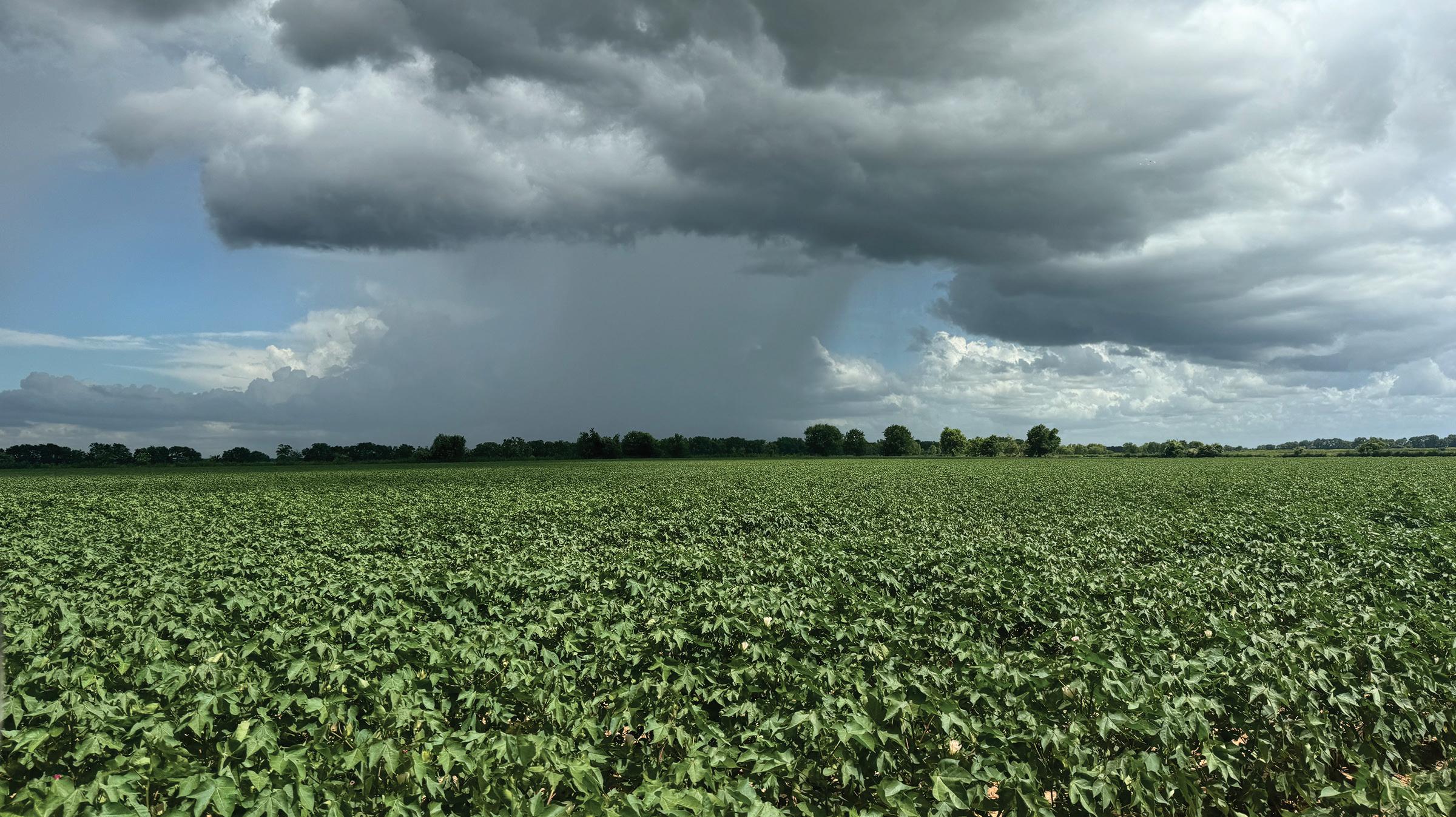
mid-season weather conditions. Some areas required a replant, and the growth stage of cotton in this region ranges from squaring to peak bloom. Many of the early planted dryland fields have good yield potential and some growers are estimating a 2 to 2.5 bale per acre yield currently.
Many fields in the Blackland Prairie never dried enough to get planting equipment into the field, and acres will be down compared to previous years in this region. The growth stage of cotton in the Blacklands also varies considerably, and early July is still too early to gauge yield potential for fields in this area. June rains in the Rolling Plains improved conditions, but with hot, dry weather recently, some areas within the region have become abnormally dry again. A few more decent rainfall events in the Rolling Plains would greatly benefit the dryland crop as the growing season progresses. bmcknight@tamu.edu
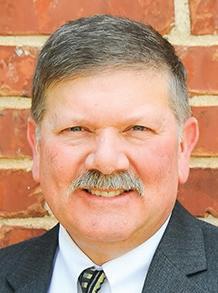
It seems the entire cotton world was waiting on the June 30 USDA acreage report to see if the planted acreage was substantially different from the prospective plantings report from a few months ago. In particular, there was much interest in Texas’s acreage, and even more interest in the West Texas crop. Compared to 2023, growers in Texas planted 15% more in 2024, and much of that increase was from West Texas.
The panhandle area (Amarillo northward) was able to plant substantially more acres than the disastrous 2023 season, when many acres were not able to be planted, and much of what was planted was ultimately abandoned. Similarly, timely rains in the Southern High Plains from Tulia, Texas, southward to the Big Spring, Texas, area allowed growers to plant more acres, the majority of which are dryland.
Continued showers have sustained the crop thus far as of this writing (July 3, 2024). It goes without saying that continued rainfall is needed on all West Texas acres, regardless of irrigated or dryland, to keep abandonment at a minimum. Growers, as well as all the associated infrastructure
like gins, equipment dealers, gin manufacturers and suppliers, all need a good year to bounce back from the tough conditions of 2022 and 2023.
Heat units are 15%-20% ahead of the long-term average, but that has been the “normal” situation for the past few years. I’ve been tracking heat units at Lubbock for 11 years now, and it has been above the long-term average (since 1911) for that entire period. It is, indeed, warmer than it was in the past, regardless of the cause. Is it climate change, or are we on a warming trend that will reverse at some point? Only time will tell. Regardless, we have had to adjust our production practices to compensate for that increase in temperature. Similarly, our water situation continues to slowly deteriorate as the levels of the Ogallala Aquifer, so growers have had to adjust their irrigation schedules and yield goals accordingly.
That said, our 2024 crop is in better shape than it has been in at least three years, and perhaps in the last five years in some locations. Good growers, good stand establishment and timely rainfalls can take most of the credit.
With timely rainfall comes weed flushes, but growers in West Texas have generally done a great job staying ahead of the weeds. There has been an increase in the use of yellow and white herbicides this year, and the rainfall has helped the activity of those tools. Related to the rainfall also is the vegetation in ditch banks and field edges that have supported populations of grasshoppers and fleahoppers. We saw more cover crops used than in previous, drier years, and that has certainly contributed to the increased populations of those insects.
As of this writing, grasshoppers have been mostly controlled either on field edges or even by spraying the surrounding vegetation, and fleahoppers have been confined to the surrounding vegetation. However, by the time this article is published, I’m quite sure some treatments will have been made in cotton fields.
Plant growth regulator questions have come in as well, and we have seen more need to control growth and encourage earliness. If we continue to receive timely rainfall, we will need to continue to monitor fields for PGR use well into bloom. Not a bad problem to have in West Texas! ken.lege@ag.tamu.edu
BY CASSIDY NEMEC ASSOCIATE EDITOR
The beginning of the 2024 summer kicked off with a couple big field days around the Central and Upper Gulf Coast Texas regions.
Bayer In Needville
Bayer hosted its annual Needville, Texas, field day June 11 at Paul and Linda Freund Farms. The tour included stops at their Dekalb corn, Bayer herbicide chemistry, Dekalb grain sorghum and Deltapine cotton trials.
They highlighted their new corn VT4PRO technology, which includes the three above-ground modes of action — Cry1A.105, Cry2Ab2 and Vip3Aa20 — found in the Trecepta technology and adds in two below-ground modes of action including Cry3Bb1 and RNAi technology. “I call this Trecepta plus,” technical agronomist Scott Stanislav said.
Jeff Nunley, executive director for South Texas Cotton & Grain Association, emphasized the importance of making sure the voice of agriculture is heard when the comment periods open on the federal register.
“The dicamba label was vacated back in February, and we’re operating under an existing stock order today,” he said. “Basically, the stuff that is in the supply chain is all that’s available for use.”
Nunley said there were over 500 comments submitted on the 30-day dicamba open comment period that ended June 3. “We work pretty hard from our association’s standpoint on trying to encourage growers to submit comments. When you do those things, you don’t have to write a book — you could write two sentences as a farmer — that carries a lot of weight.”
He also discussed the potential challenge of not having a dicamba label for the 2025 season.
“One of my biggest concerns is if we don’t have a label yet next year and guys go off label with something else. I’m telling you guys, that is the biggest risk you could ever put our industry
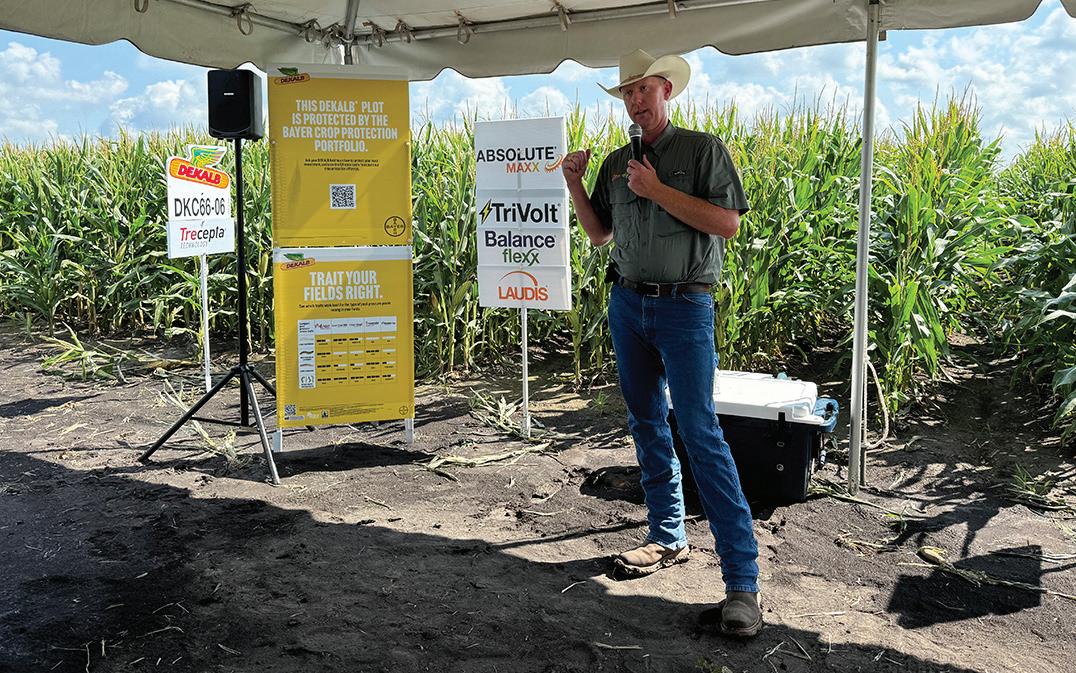
in because if that blows up on us, we may never get the label. There are alternate products out there you could use, but don’t go off label,” Nunley said.
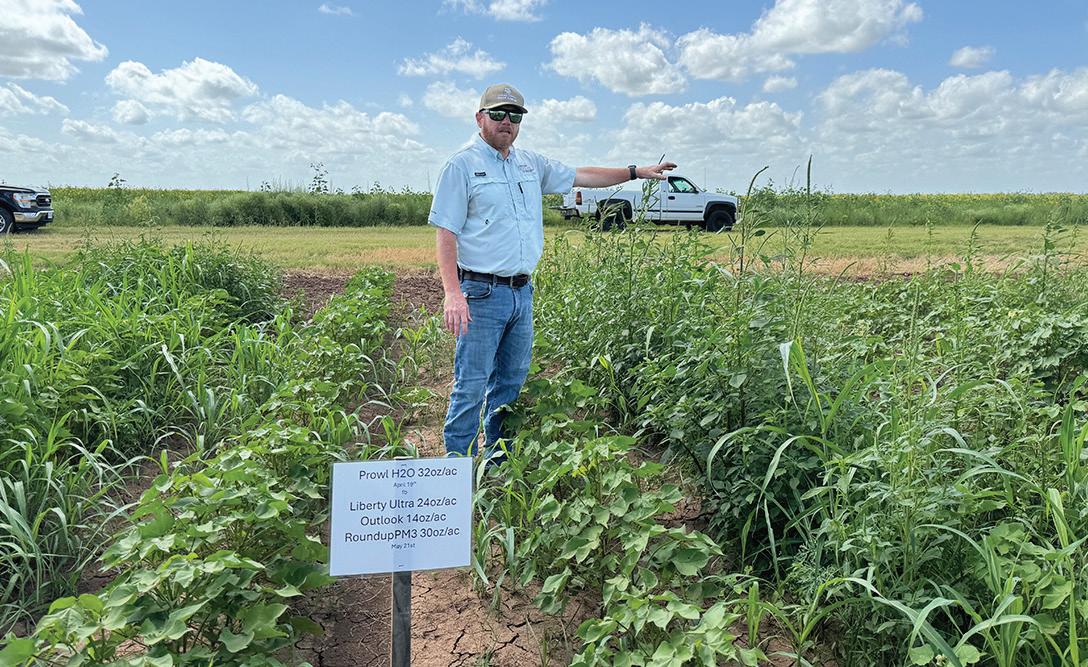
Texas A&M AgriLife associate professor and state Extension weed specialist Scott Nolte spoke on the importance of a residual and keeping up with EPA requirements.
The Texas A&M AgriLife Extension research farm on Highway 60 in Snook, Texas, was home to BASF’s innovation field day June 18.
Tour stops covered information on cotton weed control and tolerance with Axant Flex cotton and Liberty ULTRA herbicide, cotton variety trials, cotton and grain sorghum insect trials on thrips, aphids and fleahoppers, corn disease control and pecan programs and disease control.
The cotton weed control stop included discussion on the anticipated BASF launch of the Axant ISO herbicide, which is anticipated to be registered for use with the already utilized Axant Flex, quadruple-stacked, trait technology.
“It’s almost like a relaunch of isoxaflutole in this herbicide trait technology,” BASF technical service representative Adam Hixson said.
Scott Nolte, Texas A&M AgriLife associate professor and state Extension weed specialist, noted the extreme importance of incorporating a residual herbicide into your weed control program and staying ahead of the game when it comes to keeping up with requirements from the Environmental Protection Agency.
“We’re seeing what EPA has included in their work plan, things like we saw with Enlist One and Enlist Duo with the mitigation points table. That kind of thing is going to be implemented moving forward on all new products going through registration and reregistration in the future,” he said. “Incorporating a residual product into your program in a space where we are going to have fewer products available will be beneficial.”
COTTON FARMING IS THE OFFICIAL PUBLICATION OF THE GINNING INDUSTRY.
The Texas Cotton Ginners’ Association has two interns joining the organization for the summer and is excited for these young people to experience the cotton industry. Both will be with member gins throughout their internships. TCGA said they had good applicants from both Texas A&M University and Texas Tech University and settled on one from each school.
“We are looking forward to having these young men with us,” TCGA’s Aaron Nelsen said. “As in the past, we will have them report on their summer experience via the newsletter each month. Let’s meet our 2024 interns.”
Wesley Neuendor is a student at Texas A&M University majoring in agricultural systems management. He will graduate in December this year. Neuendor has worked as a master plumber over the course of his time at Texas A&M servicing multiple residential homes.
He has performed maintenance on farm equipment and earned certification training in welder performance in 2019. Neuendor was an active FFA member while in high school in Brenham, Texas. He is interning at Johnson Gin in Silverton and will finish up at United Agricultural Cooperative in El Campo.
Nathan Haden is a student at Texas Tech University major-

ing in mechanical engineering. His expected graduation date is December 2026. Haden’s work experience includes fabrication of flatbeds. He grew up on a ranch in Barry, Texas, and has experience with farm equipment.
Haden is a member of Robotics and Advanced Technology Systems (RATS) at Texas Tech University. He has used AutoCad to design components for a delivery robot in the classroom. Haden is interning with WesTex Co-op Gin in Slaton and will finish up at United Agricultural Cooperative in El Campo.
Nelsen said they are excited for these college students to have the chance to show their value to potential employers this summer. Hopefully, they will be able to gain valuable “real-world experience” and get ready to take the next step in their careers.
Stay tuned to hear from these young men as they navigate their summer internships. Following are their initial reports:
Nathan Haden — Texas Tech University
I’ve been graciously given the opportunity this summer to see how a cotton gin works. For the past two weeks, I have been working under Tony Newton, manager of WesTex Co-op gin. I’ve been blessed to get the internship when I did because
“Granberry
the gin is replacing its old bale press with a new one, and I get to be part of it.

The first week I cleaned out debris between the rollers on the module feeder, put new chains and sprockets on it, replaced some of the rollers and greased up some of the joints. That same week I was able to go to their co-op store in O’Donnell and help around there. I helped restock shelves, reorganized inventory and even observed how they kept track of items that farmers bought so they could get in and out without wasting time standing in line.
During my second work week at WesTex Co-op, we started taking out the old hydraulic pipes and electric wires for the bale press to get ready to put in the new one. It was really cool to see how much hydraulic fluid and electricity it took to run this massive press to make a cotton bale. Taking everything down took a lot of time and patience to make sure nothing was damaged in the process.
During that week, Mr. Newton was super nice and arranged a tour of PYCO. PYCO takes the cotton seed from the gins and turns it into cottonseed oil. It was so interesting to see how the seed was processed into oil and how everything from the seed was used and wasn’t wasted. The seed had to go through a cleaning process three times just to get most of the leftover lint. The majority of the waste goes to cattle feed since it’s super high in fiber and protein.
So far, the first half of my internship has been great. I have learned a lot from Mr. Newton, and I still have so much more to learn. I am very appreciative of all he has done for me. I can’t wait for my second half at United Agricultural Cooperative with Jimmy N. Roppolo, the manager of the plant in El Campo. During the season, I will get to see how all the machines work and how they problem-solve under pressure.
Thank you so much, Arron Nelsen, the TCGA and God for the opportunity to be a part of this internship.
When I first found out from Aaron Nelsen via a phone call that I had gotten the internship for TCGA, I knew I was in for a lot of new things I had never learned before. Needless to say, I have learned so many new things when it comes to running, operating and maintaining a cotton gin.

The first day I came in, I stayed in Turkey, Texas, and my point of contact was Daniel Jenkins, who is the gin manager at the Johnson Gin in Silverton, Texas. The first night was very rough as there was a good-sized tornado that had touched down near Silverton and was headed towards Turkey. Thankfully, it passed by but made for a rough night of sleep.
During the first week, Daniel showed me what he does day to day with marketing and selling production seed to nearby cotton farmers and gave me a rough overview of how the gin works. I then moved on to the Edcot Gin in Edmonson, Texas, where Landon Kidd gave me an in depth overview of how the cotton gin works, how they deal with the round modules on the module feeder and how they utilize the “Sidewinder” to unwrap and flip the round modules.
Landon Kidd then took me to Lubbock where we toured multiple cotton manufacturing companies that produce the components a cotton gin needs to run. The key places were Sam Jackson, MTS, Ford Gin Services and RAM Manufacturing where I learned how they produce and make pieces of machinery that a cotton gin needs.
I then worked with Kevin Williams and got more hands-on by helping his crew at the D&J Gin in Lockney where we were redesigning the gin with some improvements and additions to the building structure. I also got a better insight as to how he supervises all the southern region of the Windstar group of gins.
In my second week, I have been at Lonestar Gin in Pampa where I have been working with Carey McKinney, who is the gin manager. I have also been working with Dalton Skinner, who is the gin superintendent. Let me be the first to say that Dalton has been the best when it comes to how a cotton gin works, and he really knows how to work with the employees in the gin as well. Carey gave me more of the business side expertise and helped me understand what it takes to keep Lonestar Gin in business.
Carey also sent me out to Hobart, Oklahoma, where we helped Dr. Randy Bowman with cotton seed trials with 18 different seeds. We planted them to see which seeds grow better in the climate. I also got hands-on experience with Dalton where I helped some of the employees get ready for next season by performing maintenance and modifications of the bale presses, the gin stands and the lint cleaners.
I would say the first part of my internship started a little slow, but as it has progressed, I am learning so much about what it takes to maintain a cotton gin and how a cotton gin makes money. I have learned so much from di erent gin managers in the area and especially a lot from Dalton Skinner who is a person who understands how to operate a cotton gin.
I would like to thank Aaron Nelsen and TCGA for giving me the opportunity to gain experience with something I have never done before. I have learned so much in this internship. I cannot wait to see how next month goes when I see a cotton gin in operation!
TCGA provided this information.
There is a necessity for a fire prevention policy between cotton gins and cotton warehouses to minimize the risk of fire hazards in the storing and shipping of lint. These practices should be used when detecting and handling suspect fire bales: where a visible flame was present in the gin, a detection device alerted a risk and was verified by gin sta , an odor of fire was present or any other flame risk where ignition could be possible is found. These practices are recommended by the National Cotton Council as a minimum standard when working with insurance companies.
Gin practices for processing suspect fire bales:
■ Gin should isolate suspect fire bales from other bales by placing the suspect fire bales in a monitoring location as

selected by gin management.
■ Gin should isolate a minimum of two additional bales before and after the suspect fire bale for a total of five bales including the suspect fire bale, or more bales as determined by gin management.
■ Gin should notify warehouse management of any prior cotton loads delivered or in transit associated with the suspect fire bales as determined by gin management.
■ Gin should retain suspect fire bales and additional bales for a minimum of five days from the date of suspected detection at the gin premise or longer as determined by gin management.
Gin practices for the delivery of suspect fire bales after the monitoring period:
■ Gin should clearly mark the bales as suspect fire bales with approved marking materials as provided by the warehouse. Suspected fire bales should be clearly marked with adhesive tags or tape on both sides of each bale. No markings may be added to the exterior of the bale that cannot be removed without risk of damage to the bagging material.
■ Gin should identify suspect bales on the appropriate reporting to the warehouse sta .
■ Gin agrees that delivery of suspect fire bales is limited to daytime shifts of warehouse operation hours.
■ Gin sta should load suspect fire bales to the back of the truck when shipping to aid warehouse sta in identifying suspected fire bales in a mixed load.
Warehouse practices for processing suspect fire bales:
■ Warehouse sta should isolate the suspect fire bales on arrival at a designated area.
■ Warehouse sta should receive, record the location and issue warehouse receipts at the warehouse’s discretion for the suspected fire bales.

Like gins, cotton warehouses also have practices for processing suspect re bales.
■ Warehouse sta should conduct daily monitoring of the suspect fire bales and return the bales to inventory after a monitoring period is completed as determined by warehouse management.
■ Warehouse sta should remove markings or adhesive tags designating suspect fire bales after monitoring period is complete.
Gin and warehouse should each agree to practice and implement these procedures for suspect fire bales and notify each other of any alterations or deviations to agreed-upon practices regarding suspect fire bales, prior to implementing any new practices.
The National Cotton Ginners’ Association provided this information.

Lummus Ag support an and adapt Lummus of profitable. your succe
g Solutions w d business. W to changing m
wants to expre With the chal market condi
ess its apprec llenges we fa itions and cus
ciation to our ce in our indu stomer needs
r many loyal c ustry, we are s.
ffers a wide ra Regardless ss.
Just a shor All-new Ginning system Press C Burner Air Mon DGC 20
t list of items w complete Gin P g Machinery (in ms, presses, etc. Consoles and M r and Moisture U nitoring and Fire 020 Gin and Fee
ange of produ of the project s we offer: Plants ndividual machin ) ain Control Con Unit Gas Train/C e Detection Kits eder Controls
ucts and serv t scope, cont
nes, stand-alon
nsoles
vices, all gear tact Lummus e des Gin
red to help yo to discuss yo
As our nam parts, servi
me states, we ice, or techni
stand ready t ical expertise
Controls upgrad s to offer you S e, we will be h



n Dor-Les® and E
customers for continually w our operation our goals and E.E. Dor-Les® Pr
• 16” diameter
• Hydraulic Tram
r Bottom Ram Co mper/Pusher C
• Premier™ III S
Qua Unm
SOLUTIONS fo here for you n
• Press Rebuild ality OEM Repai matched Techn or your busine ow….and into

r their continu working to evo be efficient a d needs to ens ress upgrades onversion
Conversion
Series Hydraulic ds (strain rods, b ir Parts ical Service ess. Whether o the future.
c Pumping Units boxes, sills, etc
ued olve and sure s .) it is machinery,


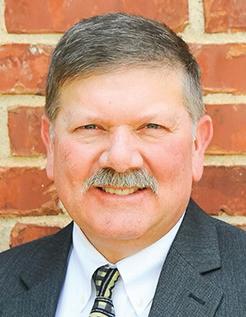
Igrew up in a little town in southeast Texas where the nearest cotton field was nearly two hours away. And yet I’ve worked in the cotton industry my entire career; how did that happen?!
When I graduated high school, I followed my brother’s footsteps and went to Sam Houston State University, destined to be a high school ag teacher like he was. During my sophomore year, I took a crop science and a botany class to “get them out of the way.” Two gifted professors who taught those courses made my life take a different direction.
One of those professors, Dr. Bobby Lane, took me under his wing, and upon graduation, I found myself on a recruiting trip to Texas A&M to explore three different graduate assistantships for a master’s degree in plant breeding. Two of those opportunities involved cotton, a crop I had only seen from the highway occasionally. I knew nothing about cotton. Enter Drs. Wayne Smith and Tom Cothren.
cotton specialist roles across the Belt, and we’re moving to Florence, South Carolina, to take the role of the state Extension cotton specialist for Clemson. Enter more mentors: Drs. Will McCarty, Paulus Shelby, Kater Hake, Johnny Crawford, Tom Burch, Randy Norton, J.C. Banks and others. I had read what these folks had written, but now I was amongst all these folks I looked up to.
Two years into that role, which I thought I would never leave, Sure-Grow Seed from Alabama offered me a role as director of technical service. They were entering into the world of transgenic cotton, as were Delta and Pine Land, and PayMaster at the time, and they were all forming their teams of agronomists to help support the advent of Bt cotton, and soon after Roundup Ready and all the other traits since. Next thing I know I’m working with Drs. Tom Kerby (who had already published every good idea I could come up with!) and Dave Albers.
“I choose to believe it was all the Lord’s doing.”
For the next six years, I learned about cotton plant breeding, physiology, entomology and pathology, and left there with a Ph.D. If you would have told me when I left that small town that I would have a Ph.D. and would be immersed in the world of cotton, I would’ve told you you’re crazy! But with the support of my parents, especially my father, who worked overtime at a Goodyear plant to pay for my 10 years of college, I had achieved what was thought to be impossible.
In two generations, we had gone from my grandparents without a high school diploma among the four of them (two of them could not read or write) to my having a Ph.D. If that’s not an example of the American dream, I don’t know what is!
While I was pursuing my graduate degrees, my wife worked as a secretary in the Soil & Crop Science department for some Extension specialists on campus. Another divine appointment put me in the path of folks like Drs. Willis Gass, Travis Miller, Don Dorsett, Bob Metzer, James Supak and other mentors from which I learned what Extension was all about.
Next thing I know, I’m applying for five Extension
Over the years, I have been able to be part of the introduction of several versions of Bt, Roundup Ready, Roundup Ready Flex, XtendFlex, Enlist, bacterial blight resistance and nematode resistance. I can’t even remember all the variety names over the years from SureGrow, Deltapine, PayMaster, Americot, NexGen and most recently, PhytoGen.
After working in industry for 27 years, I came full-circle and am back to Extension at Texas A&M AgriLife in Lubbock, sitting in the same seat once occupied by folks like Drs. James Supak, Kater Hake, Randy Boman, Mark Kelley, Seth Byrd and Murilo Maeda. Serving the biggest cotton patch in the world is not a position I take lightly, and I feel humbled to be part of that legacy.
So how did I manage to always seemingly be in the right place at the right time with the right people around all these years? Well, one might say I did a good job developing my network at the Beltwide Cotton Conferences, working with all the cotton specialists across the Belt in my various roles, or maintaining friendships with the right people.
I choose to believe it was all the Lord’s doing. Only God could’ve taken a small-town boy, with grandparents who couldn’t even read and write, to earn a Ph.D. and work among the best in the cotton industry.
— Ken Legé Lubbock, Texas ken.lege@ag.tamu.edu
Cotton Farming’s back page is devoted to telling unusual “farm tales” or timely stories from across the Cotton Belt. Now it’s your turn. If you’ve got an interesting story to tell, send a short summary to csmith@onegrower.com. We look forward to hearing from you.



















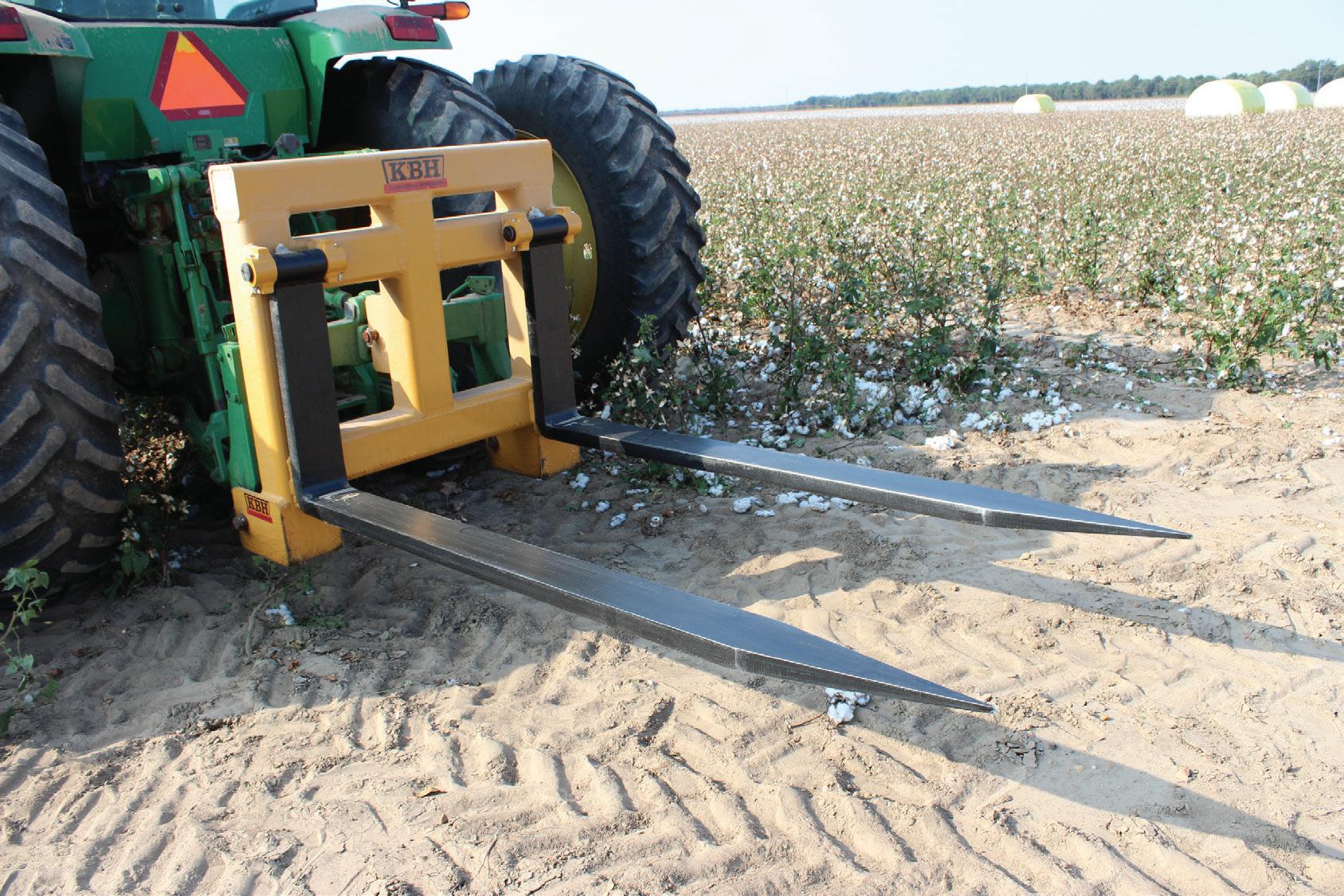















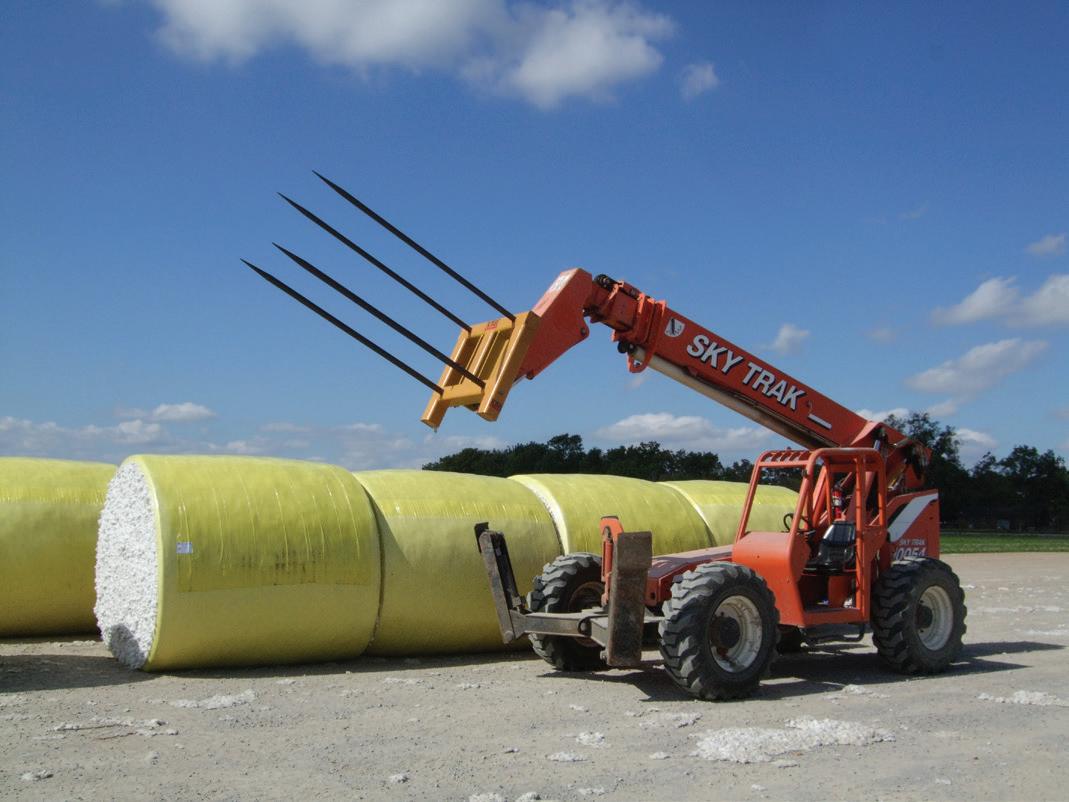





•Front-end loader or 3-point hitch










•Penetrates bales easily
•Durable 6” x 84” sharpened forks


•Adjustable stand for off-season storage










Co on F k Bale Handler Scan




•Proven performance - hundreds of thousands of bales moved over the last 10 years





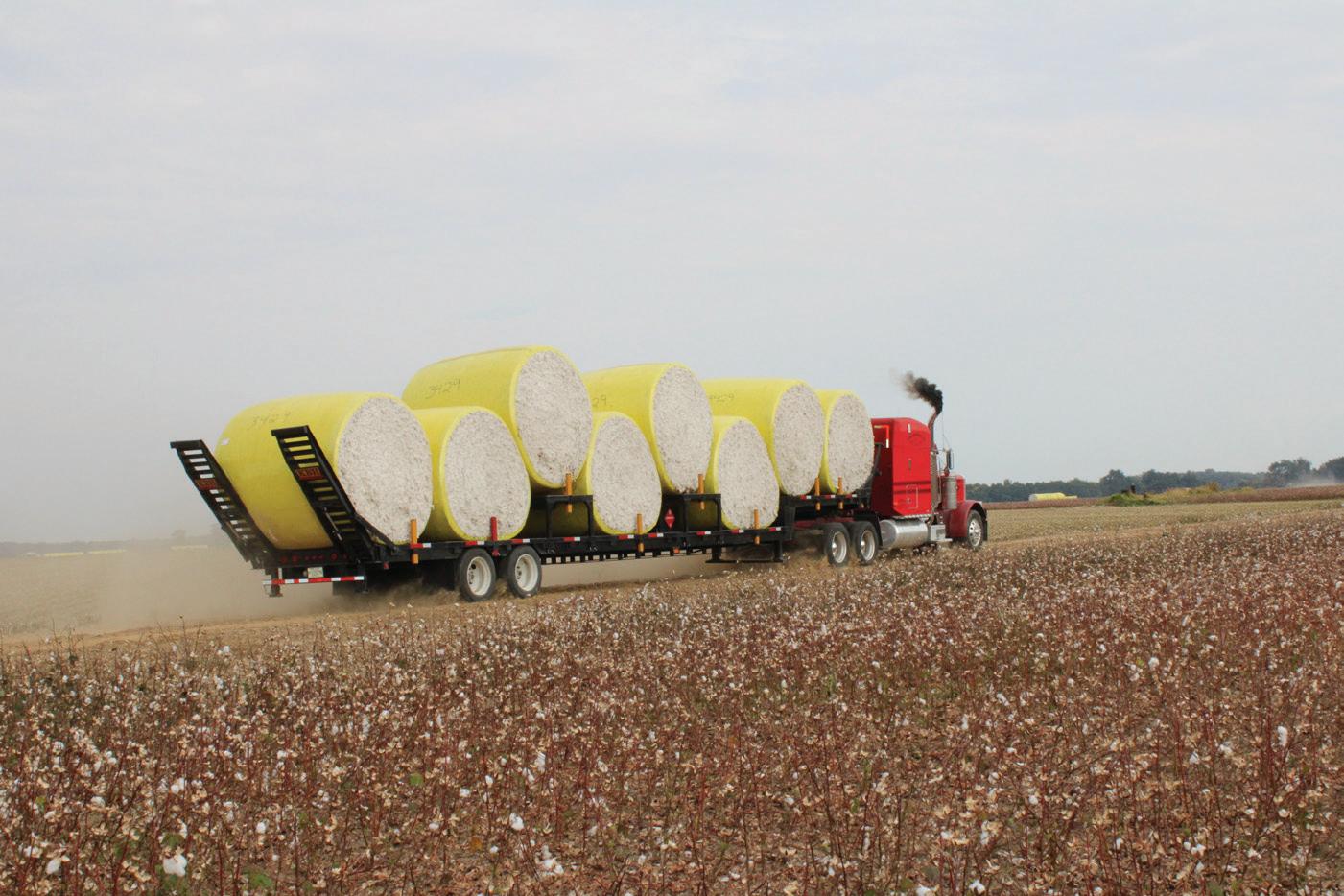

•Stalk-free transport to your gin











8-Module Capacity

•Hydraulic Ramps Optional



•Platforms elevate 2 bales easily removable by loader

















